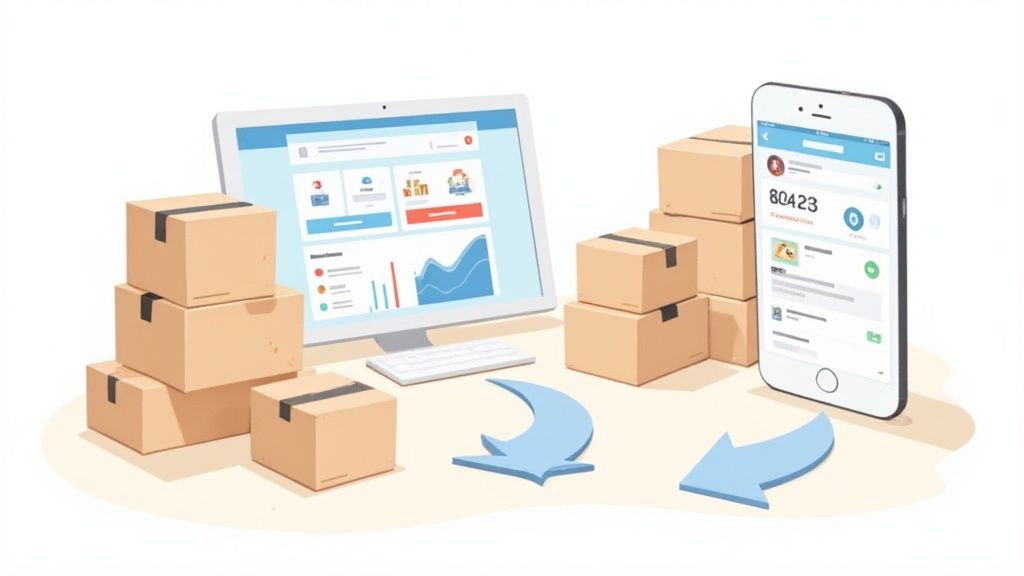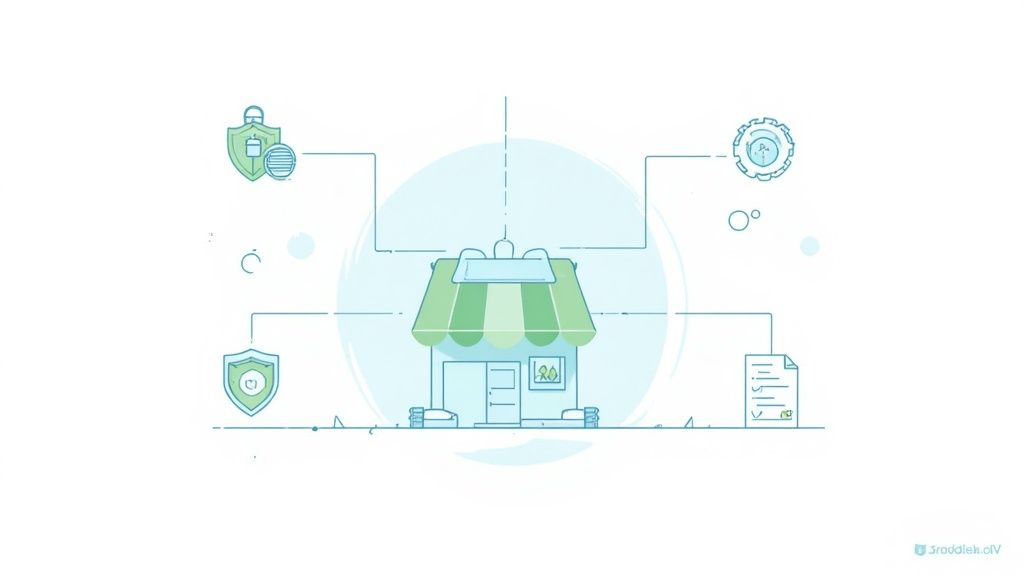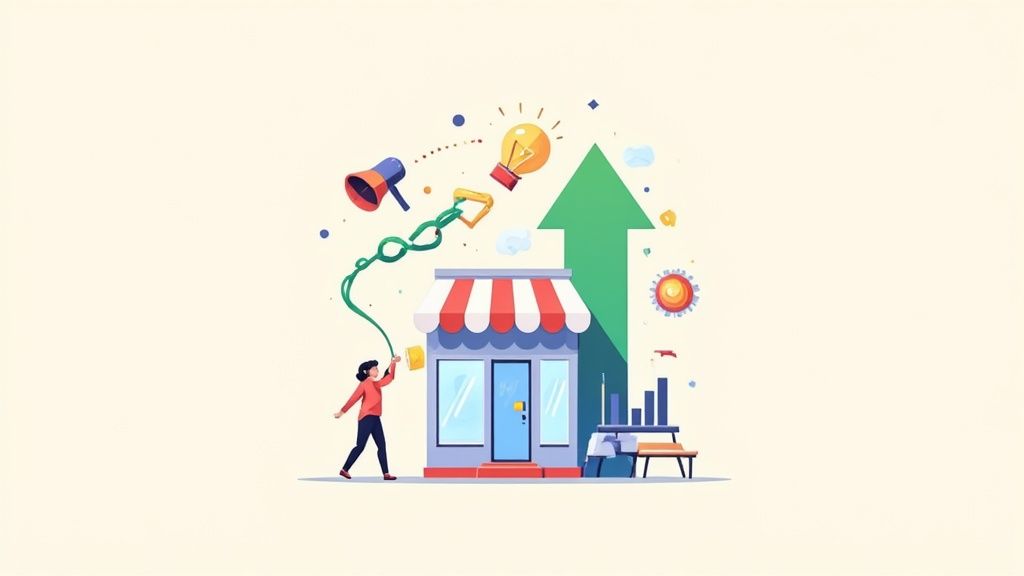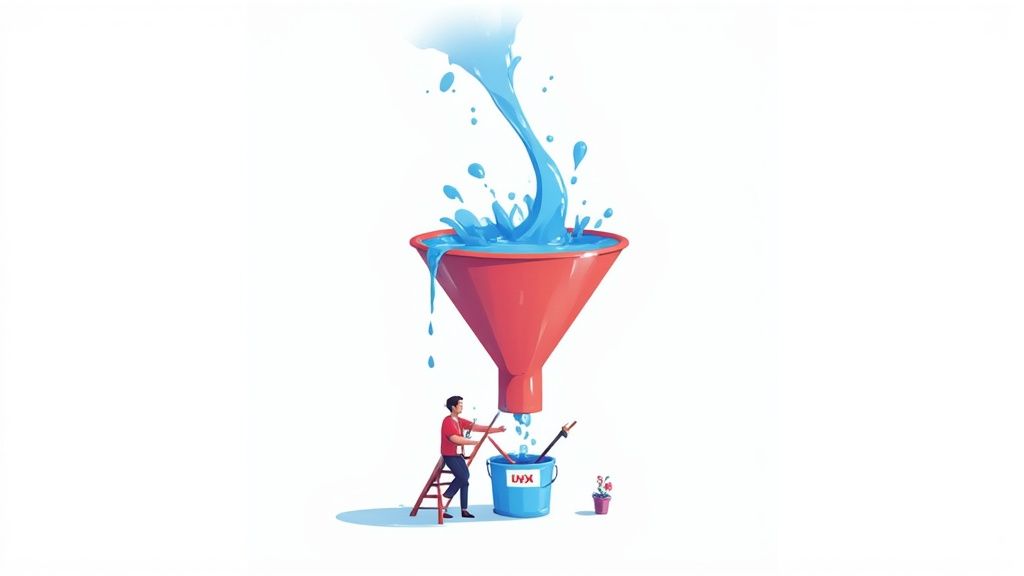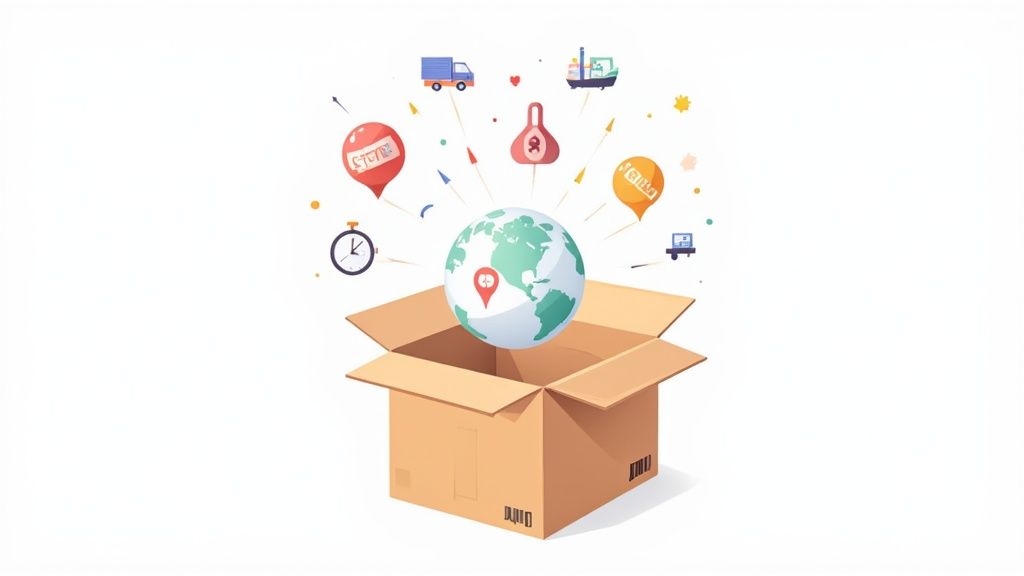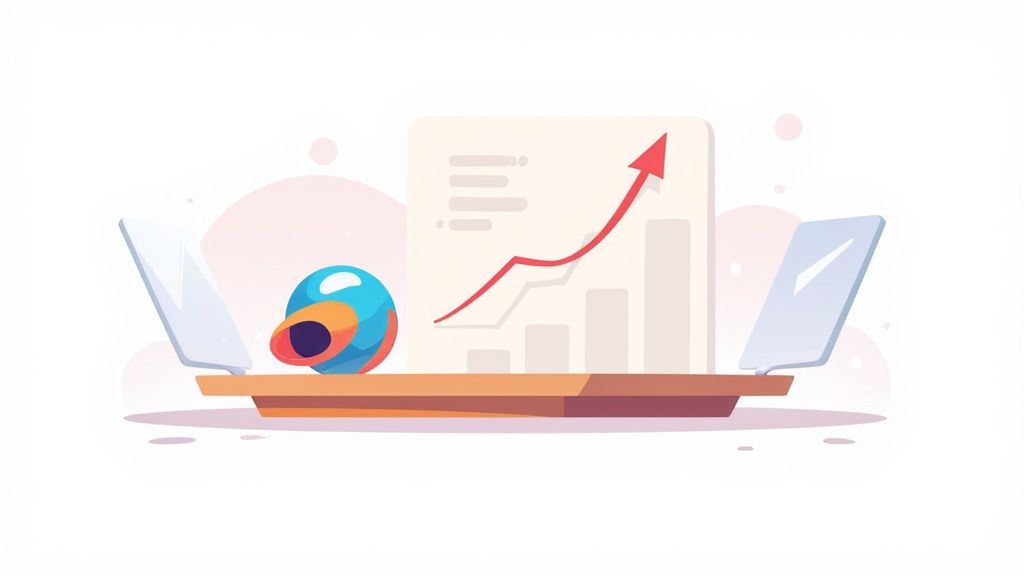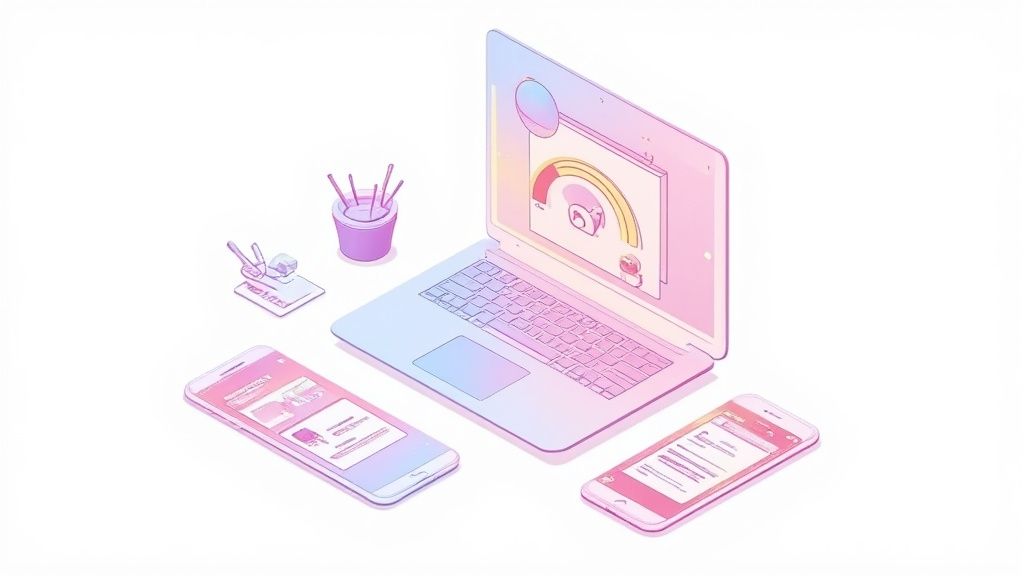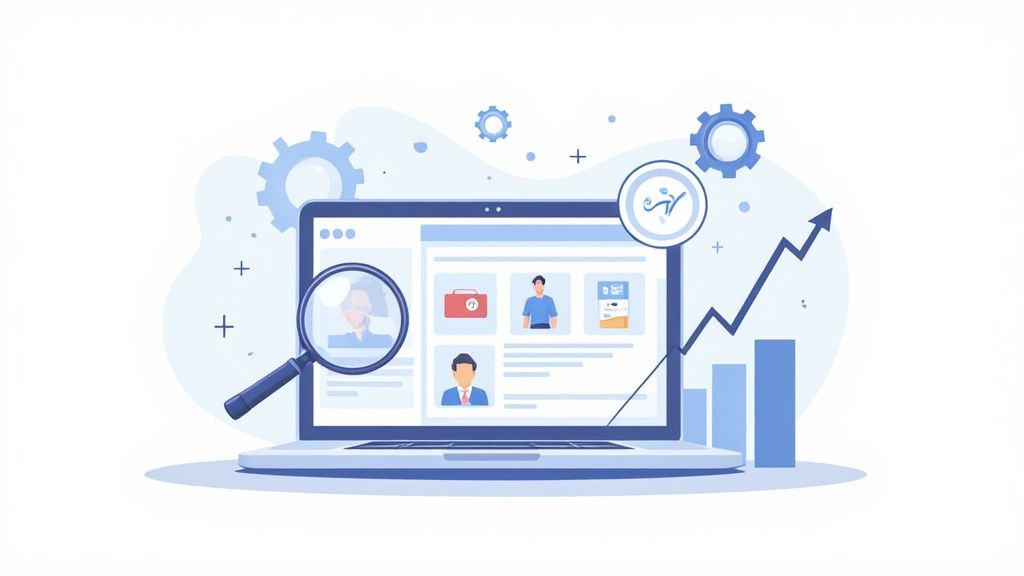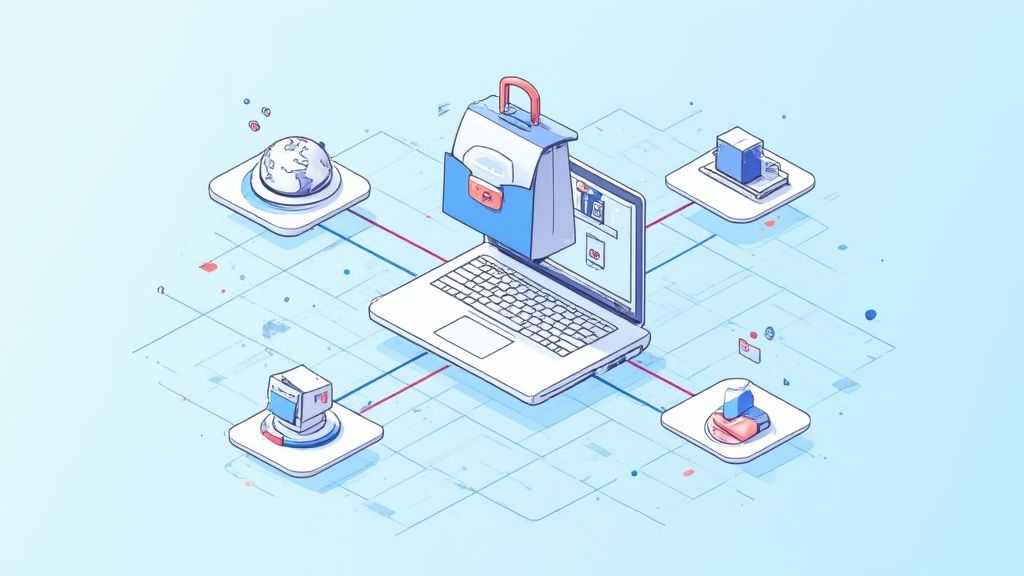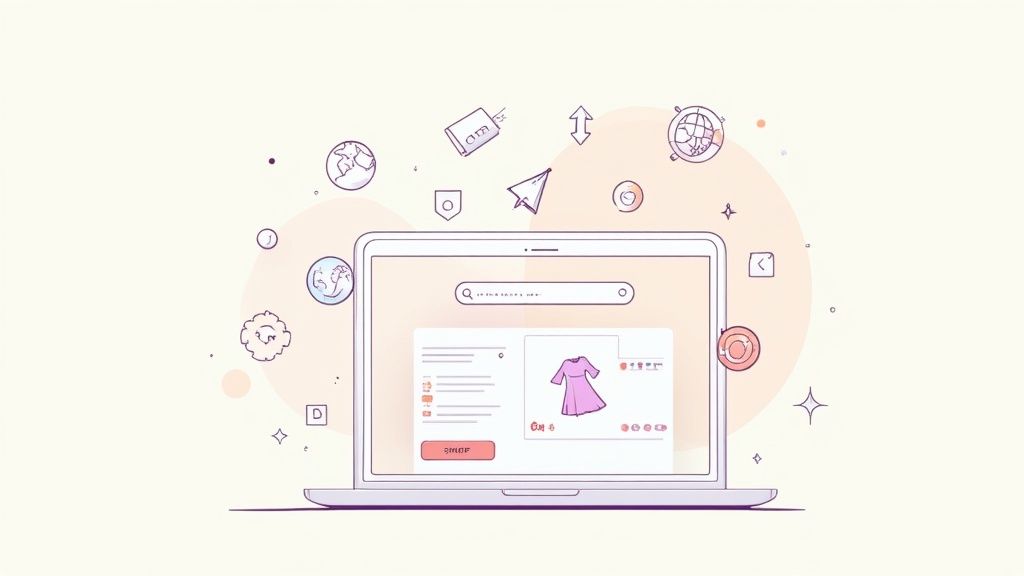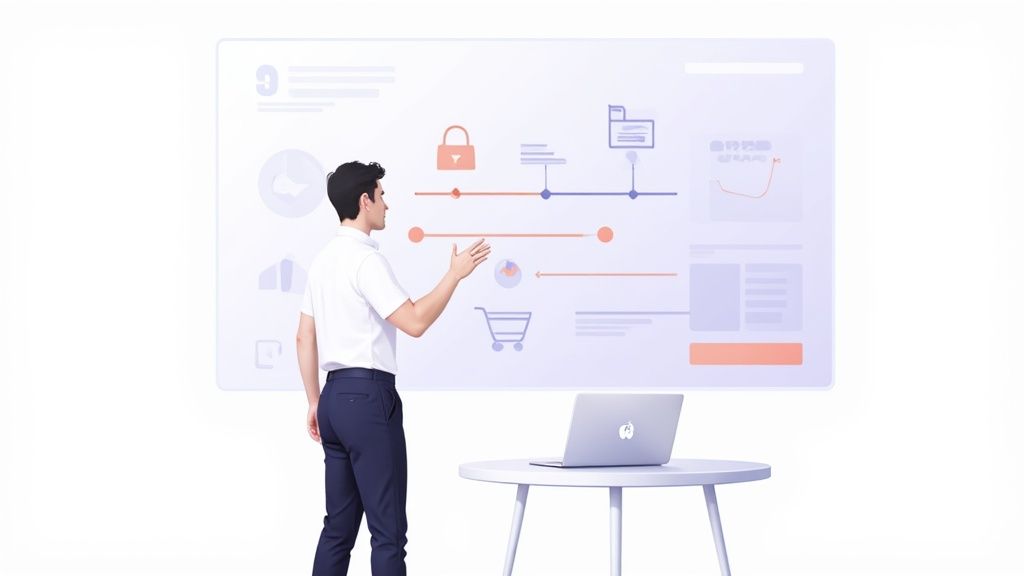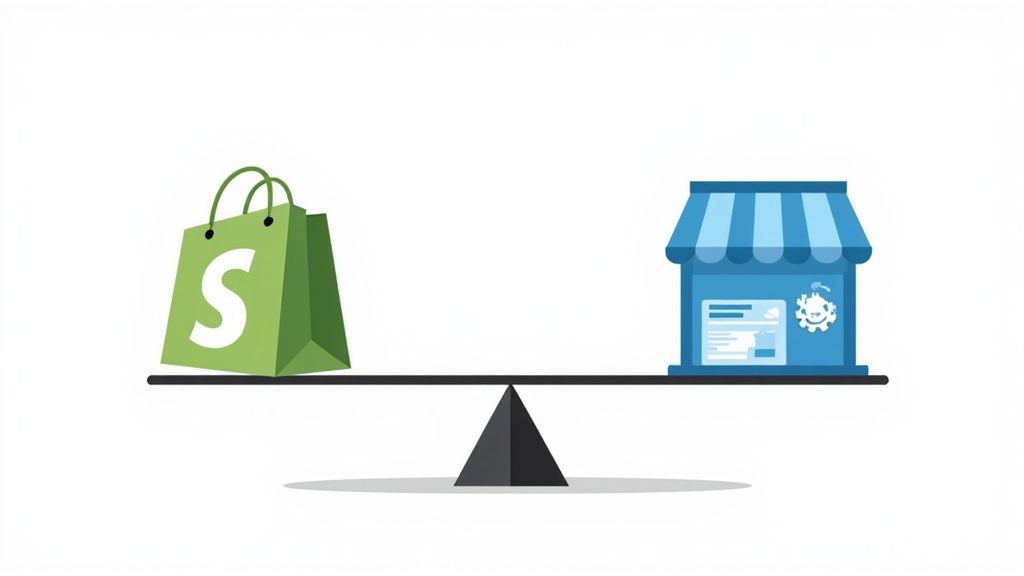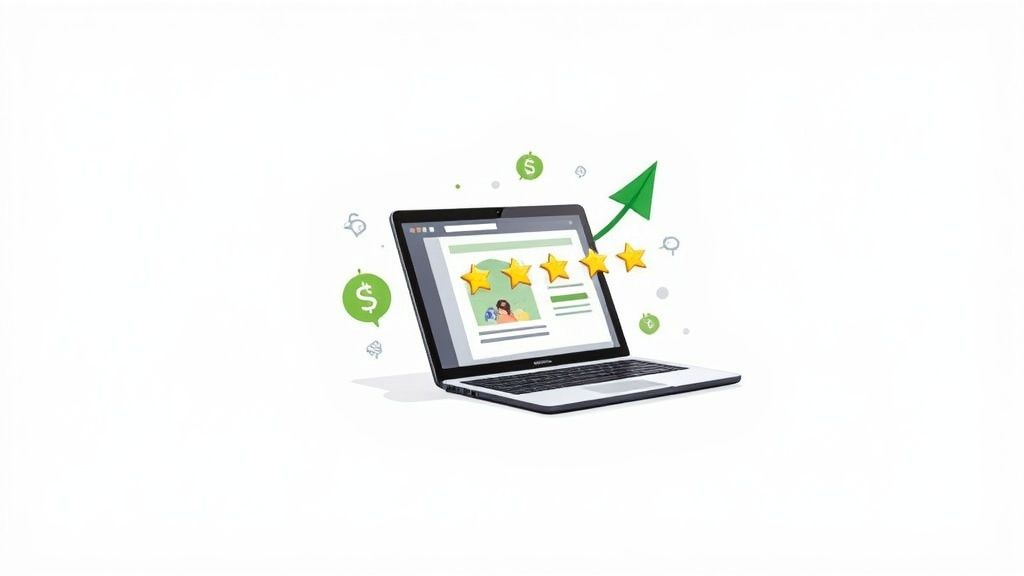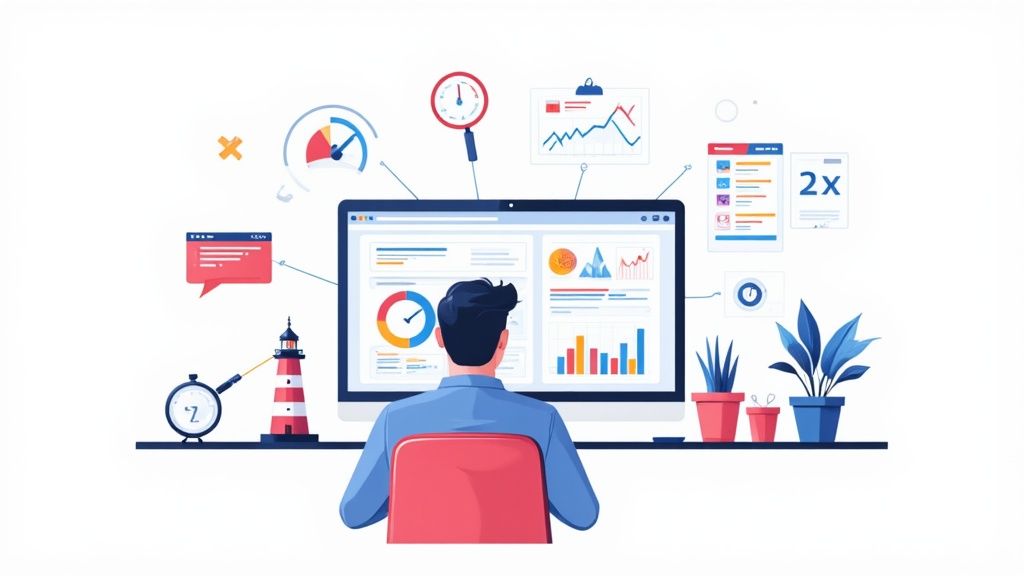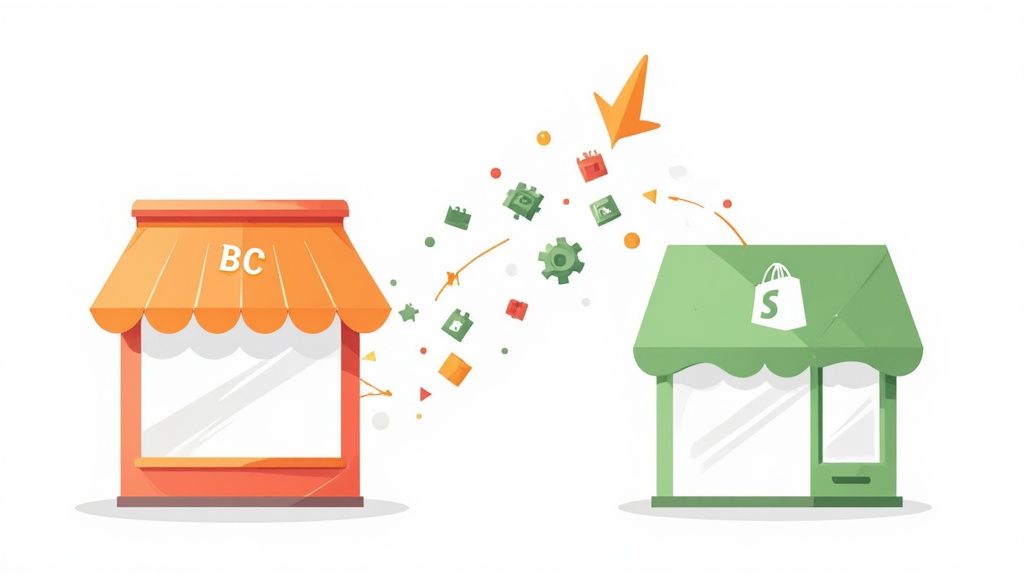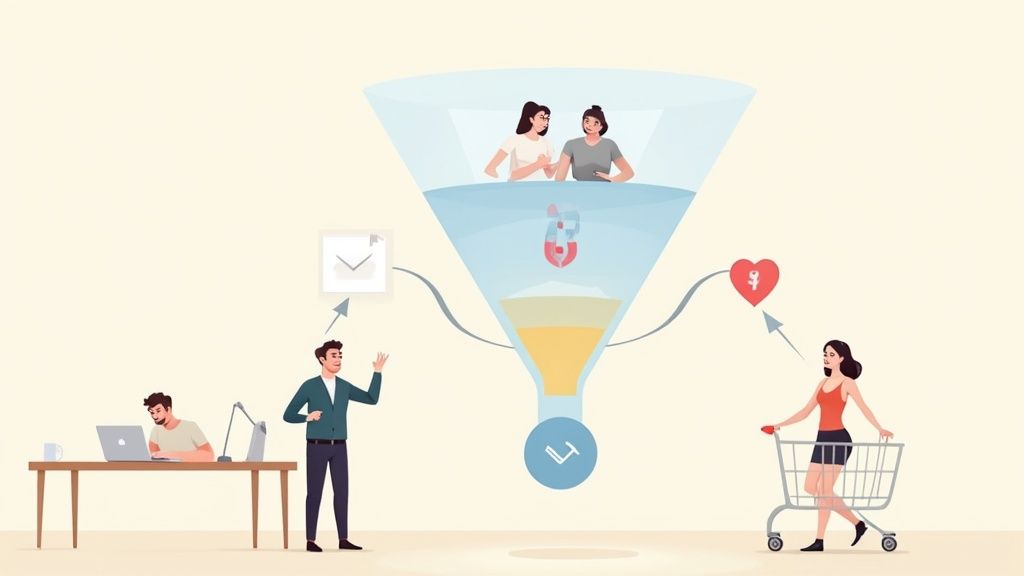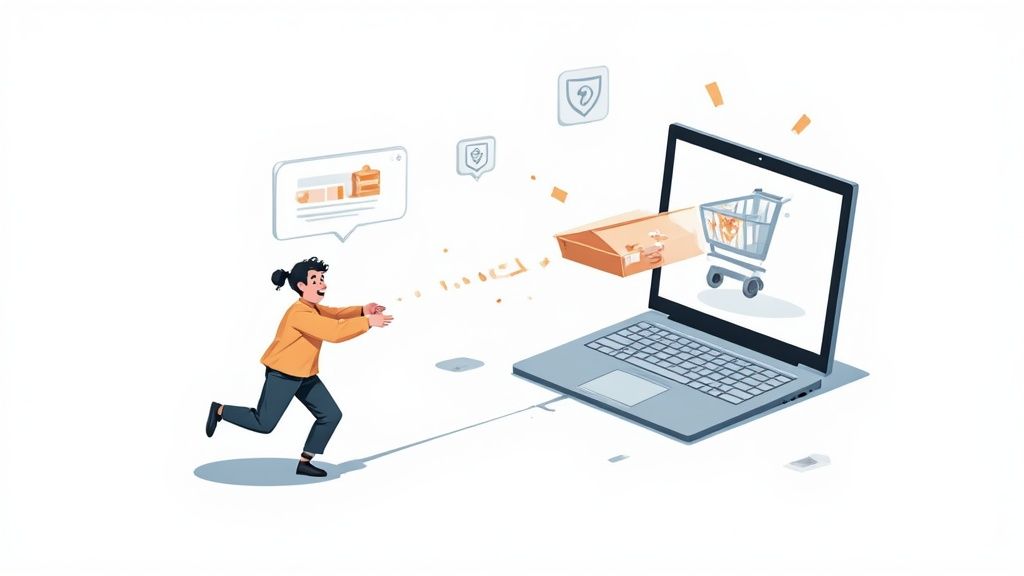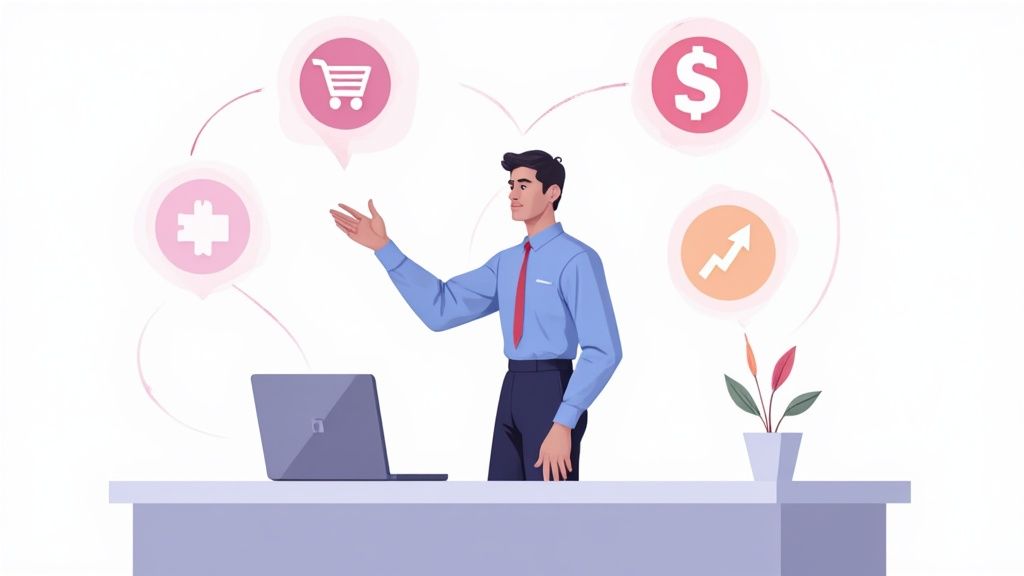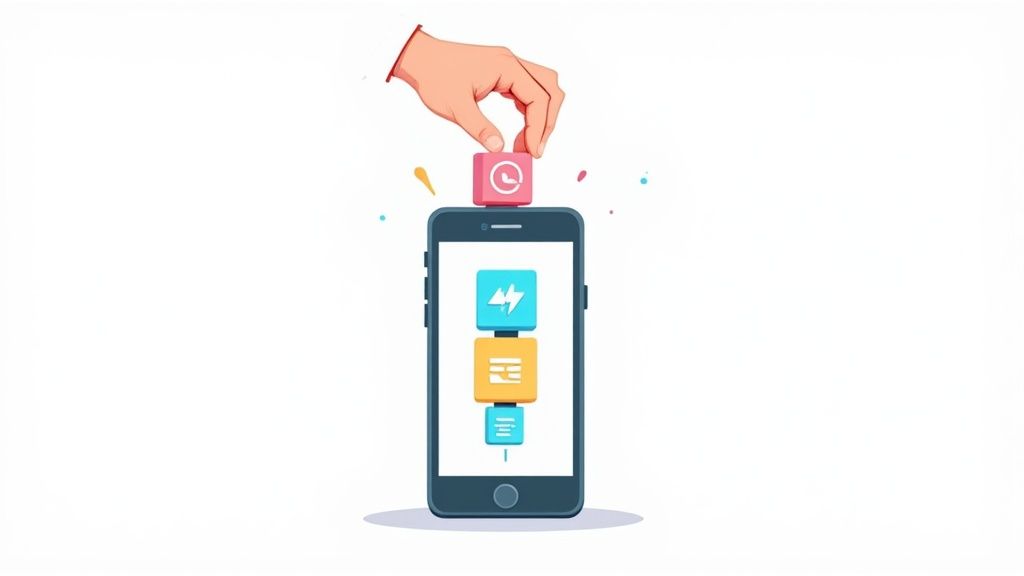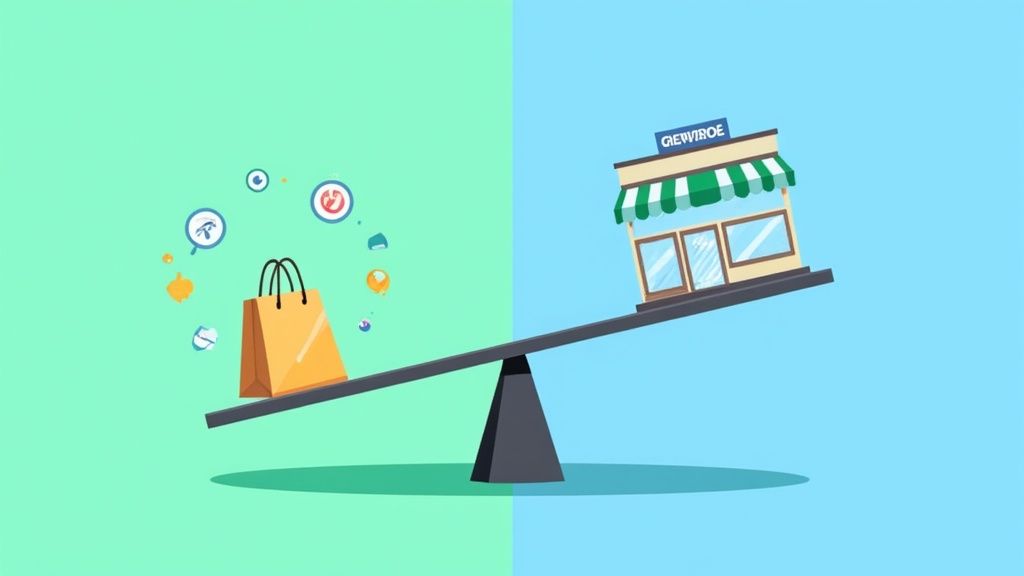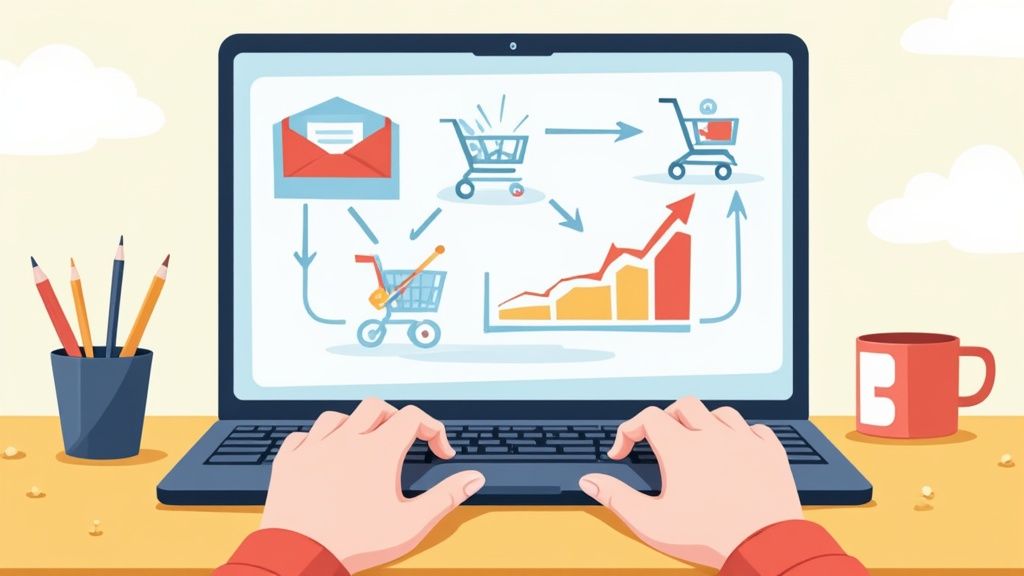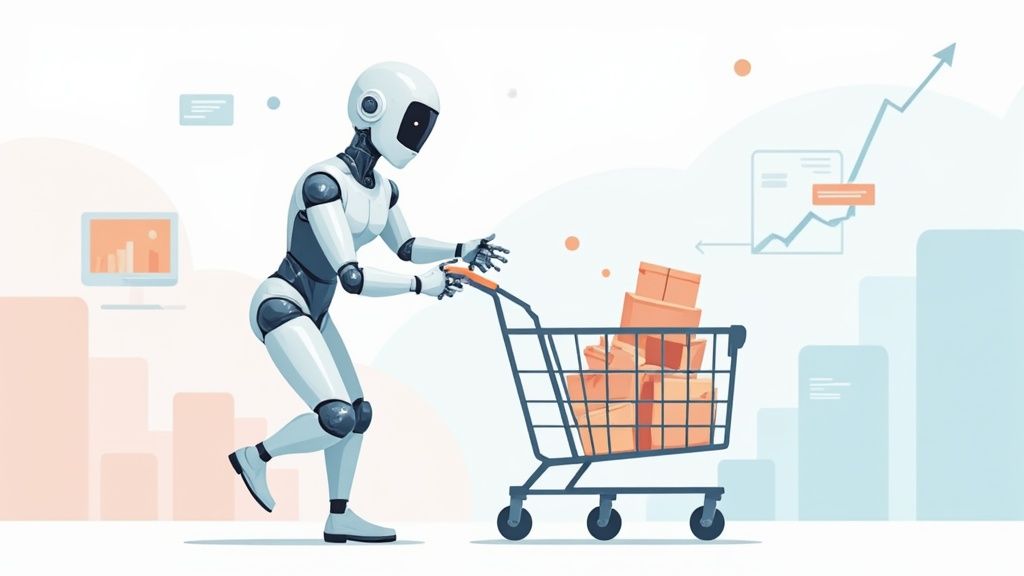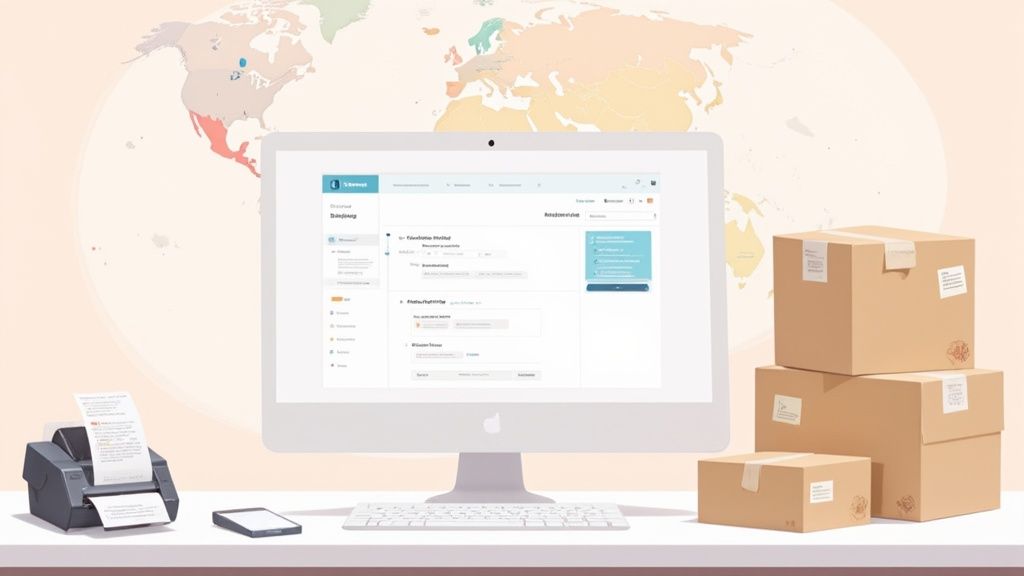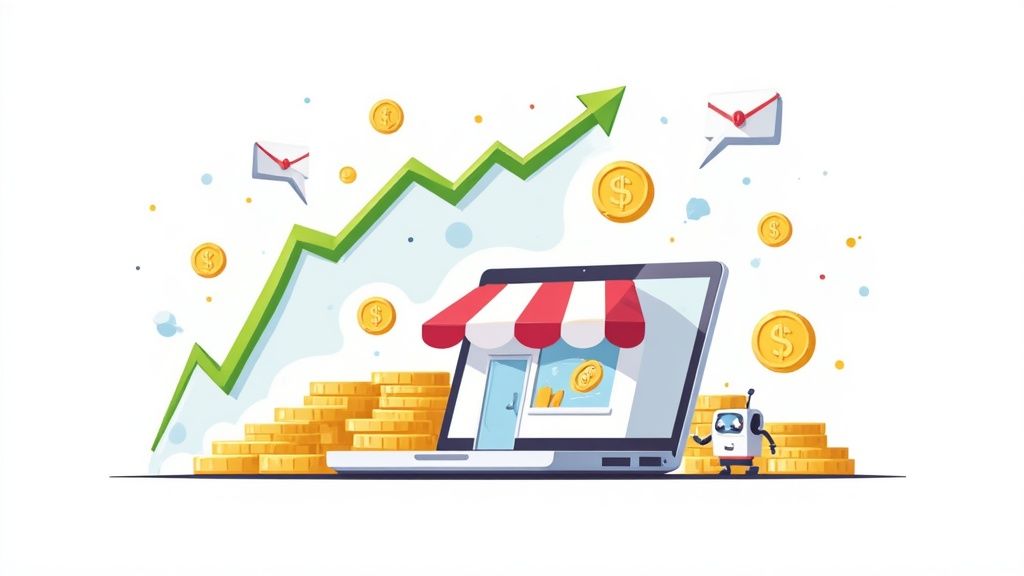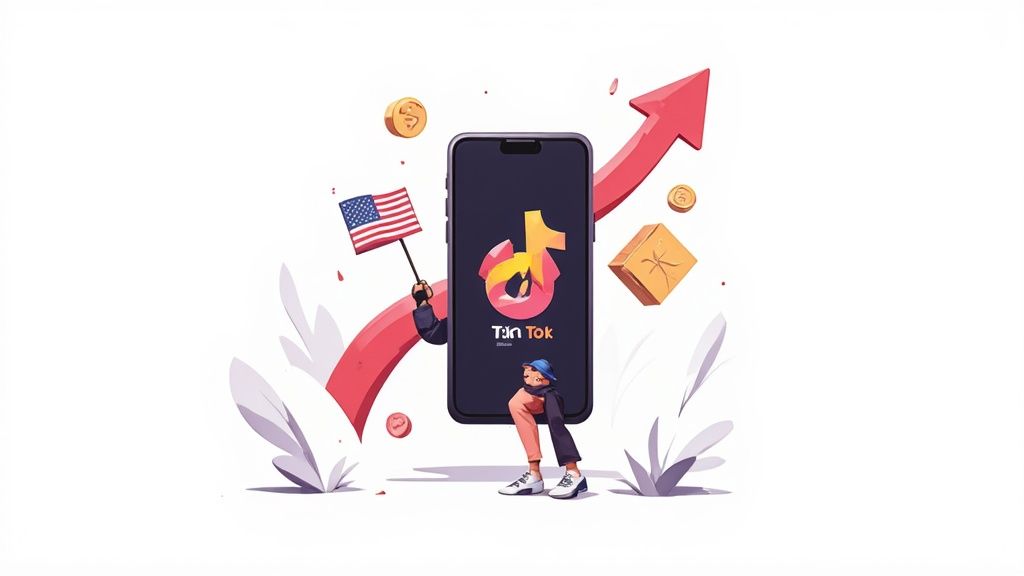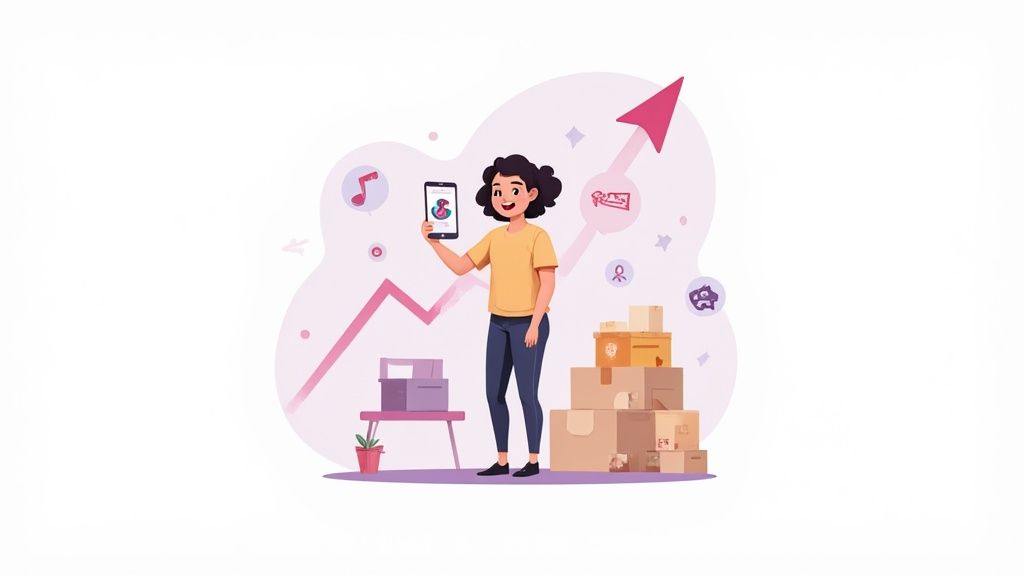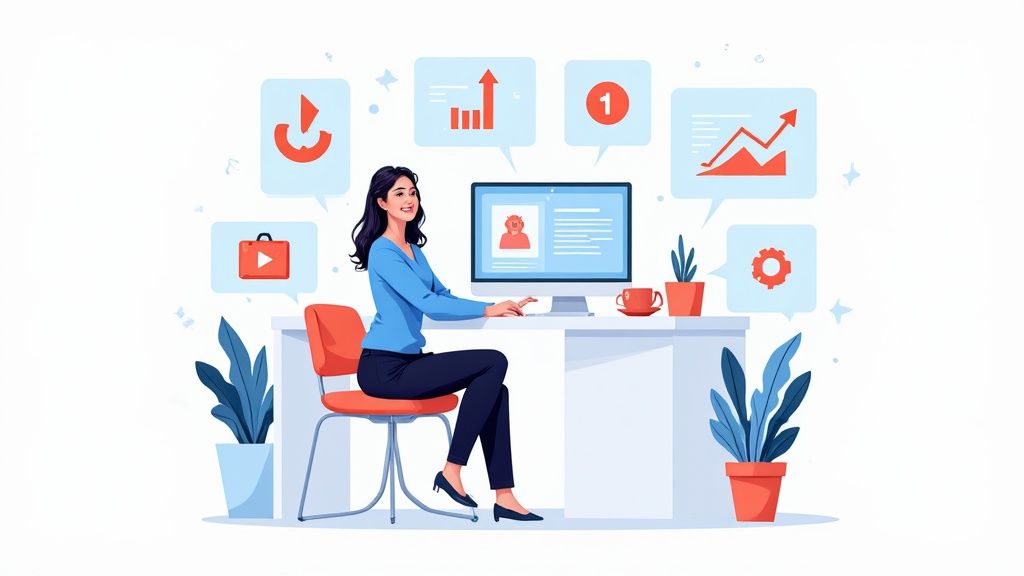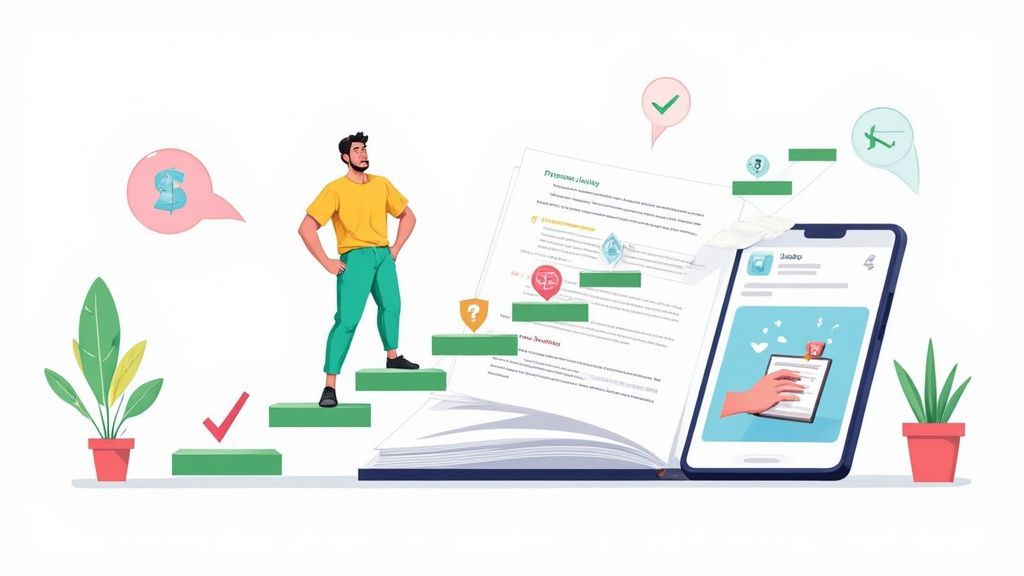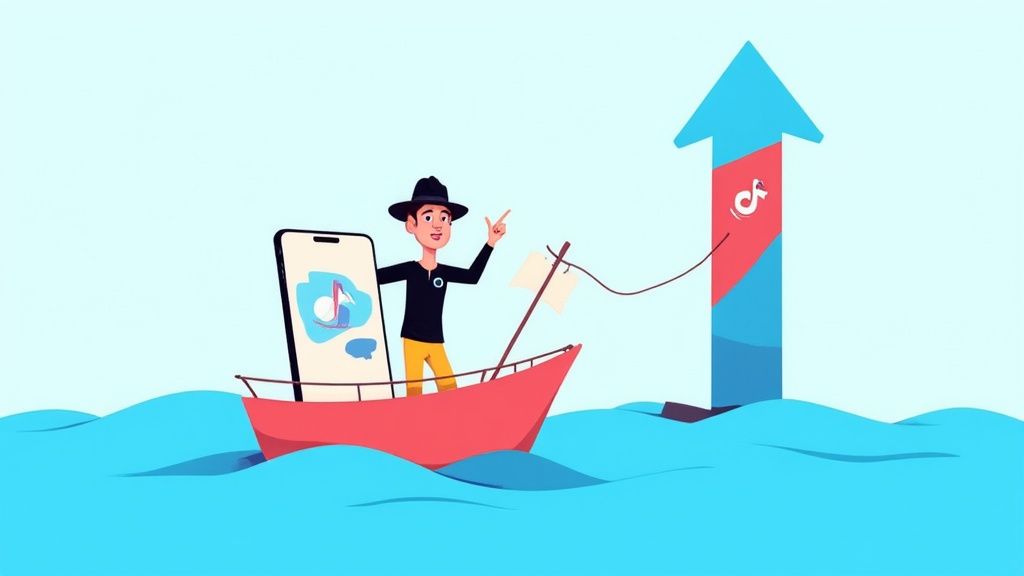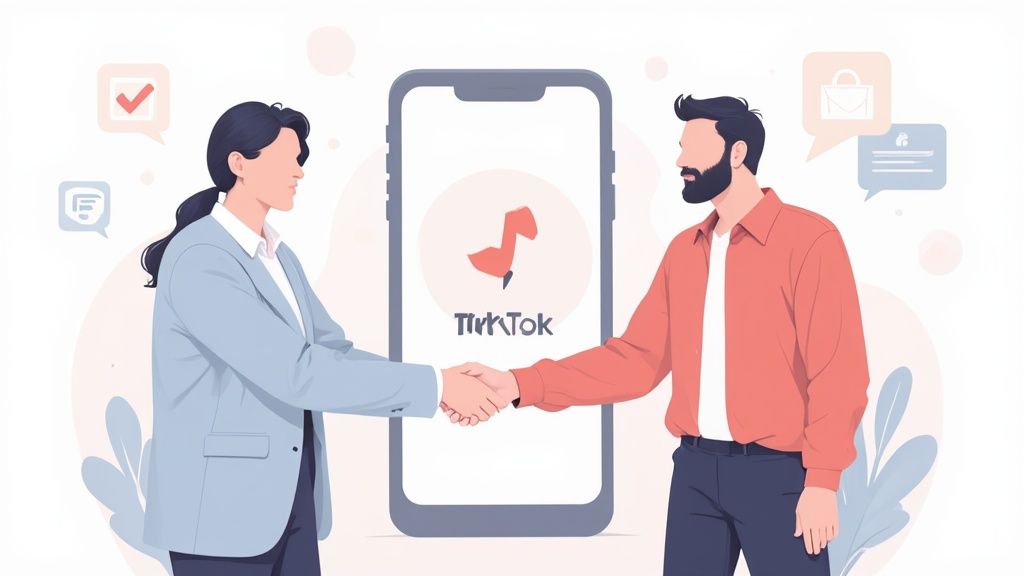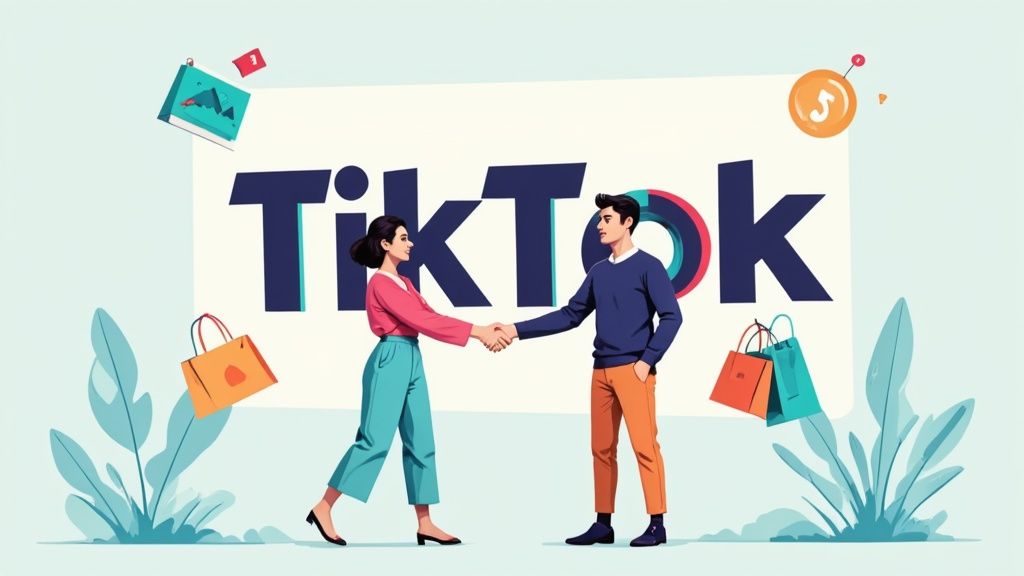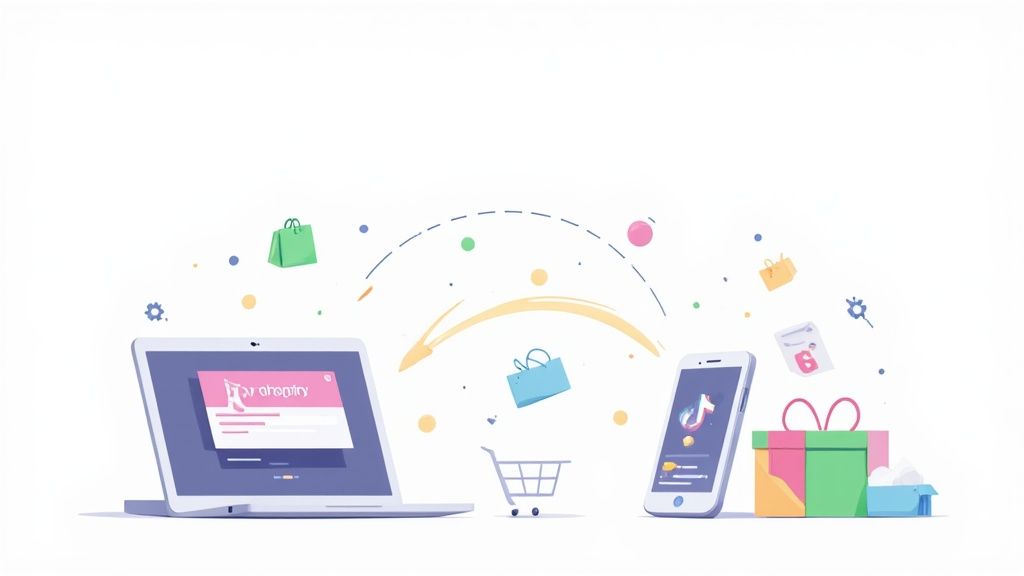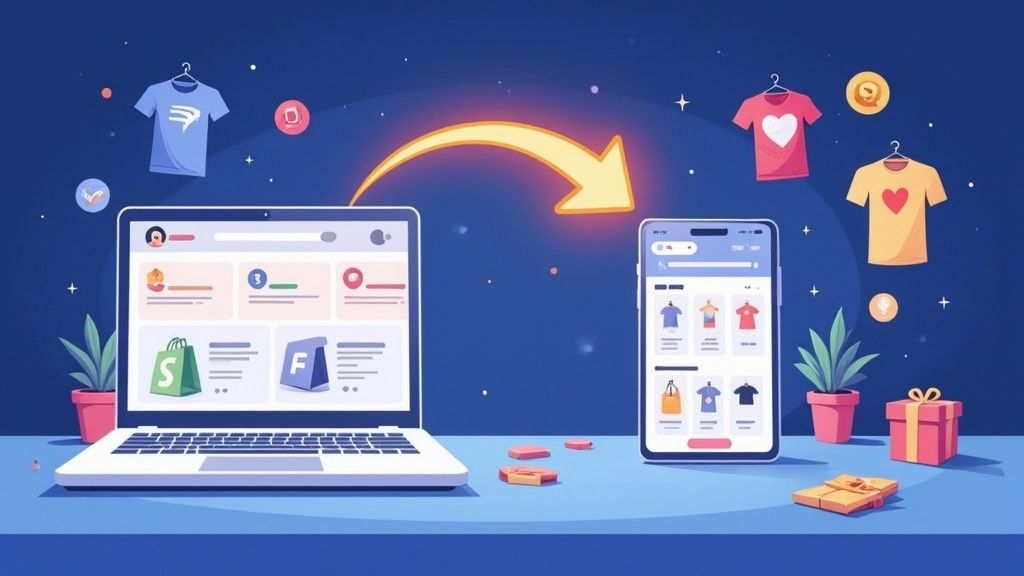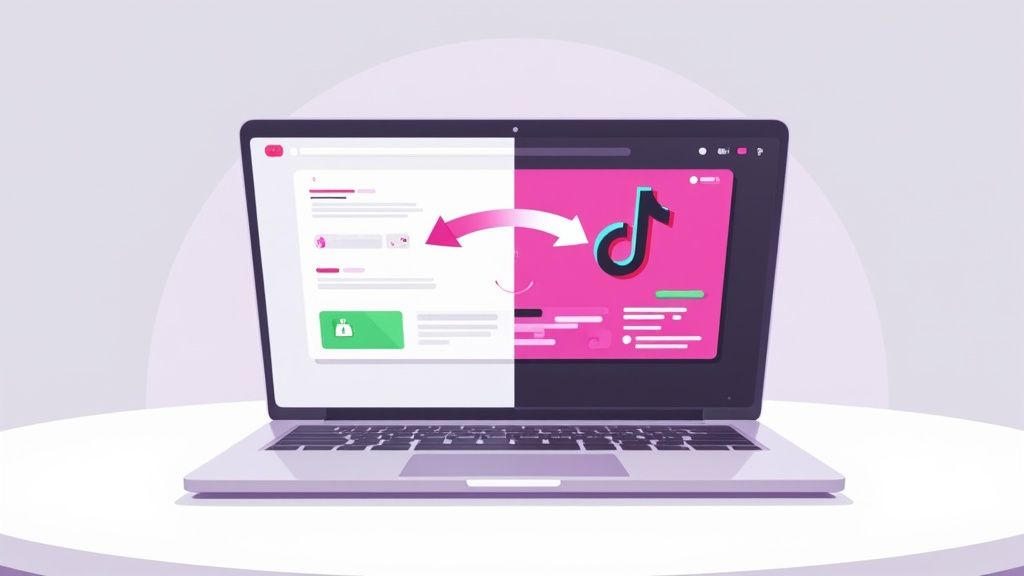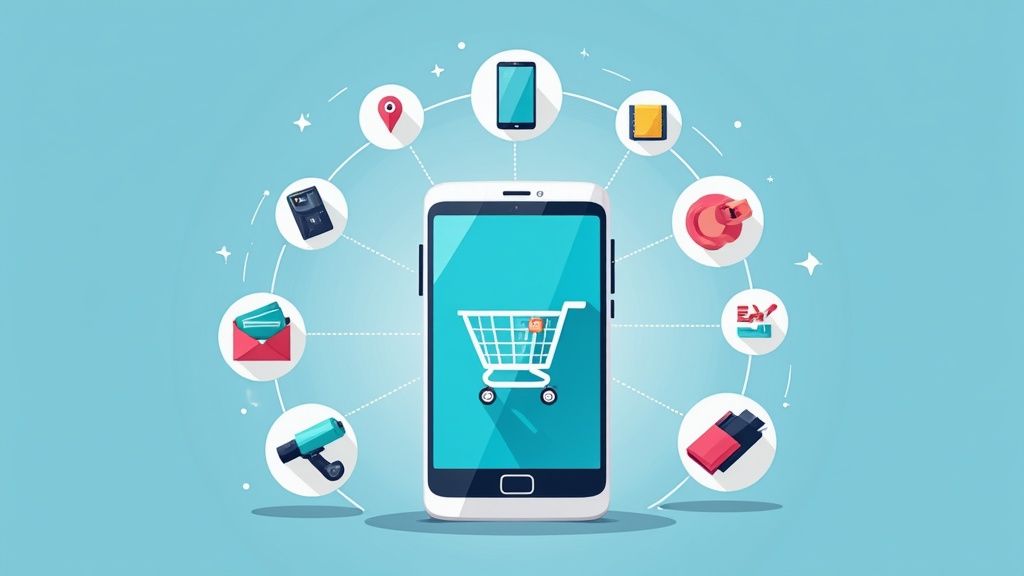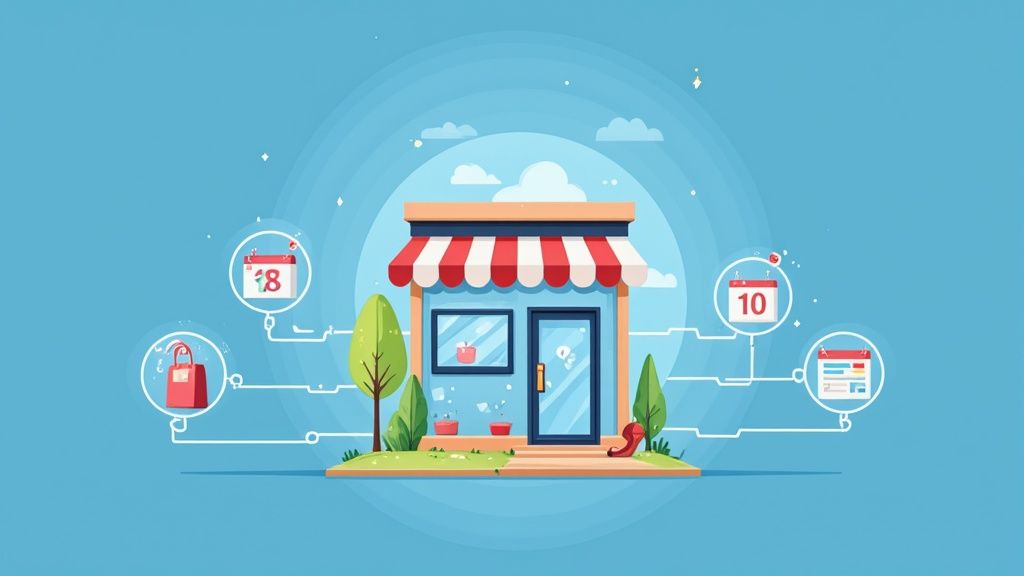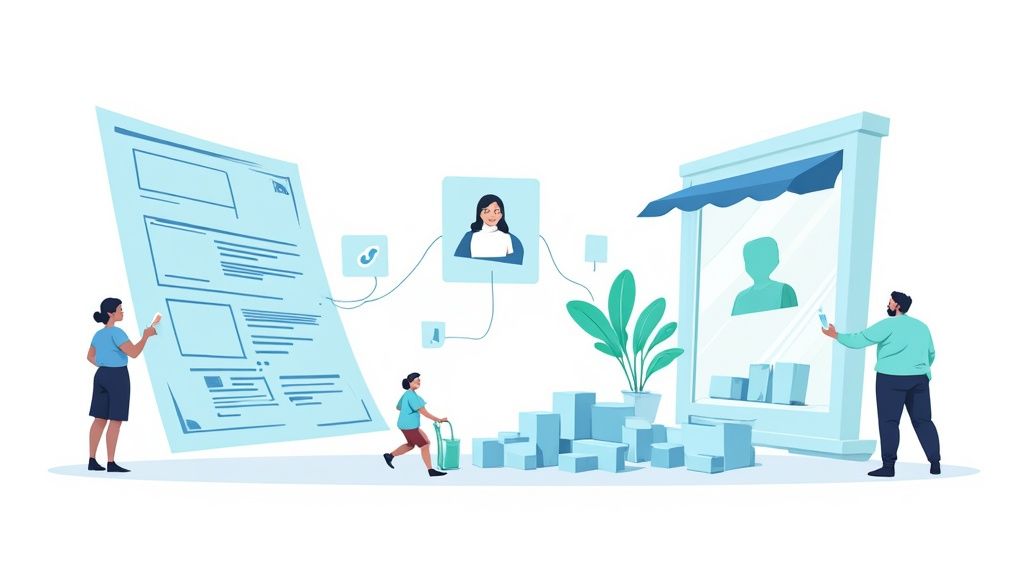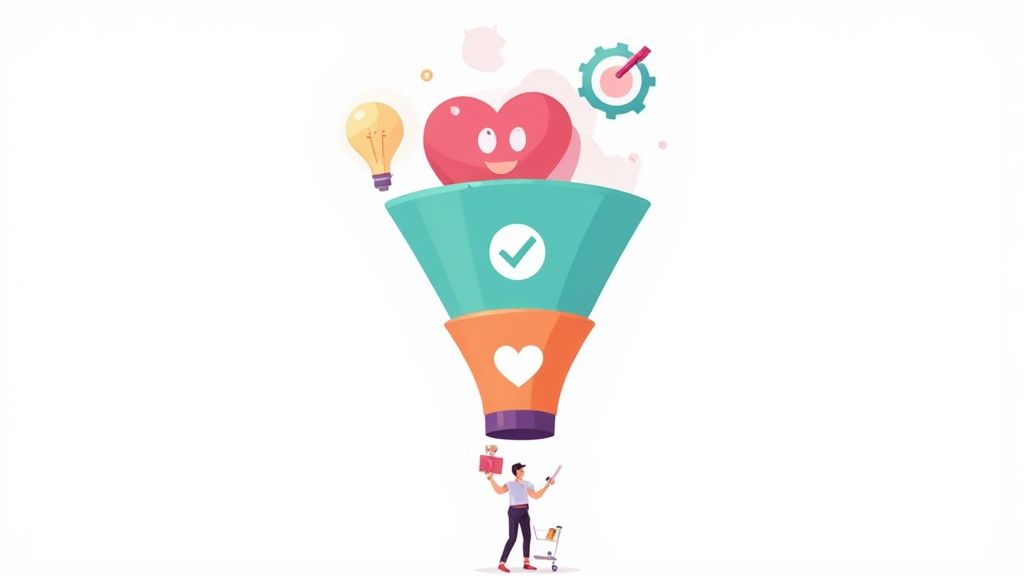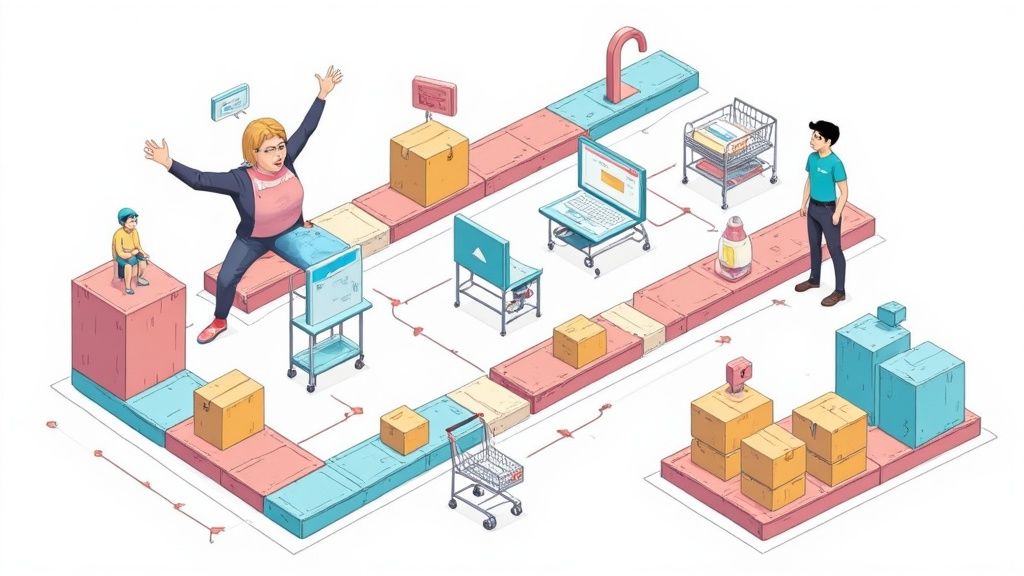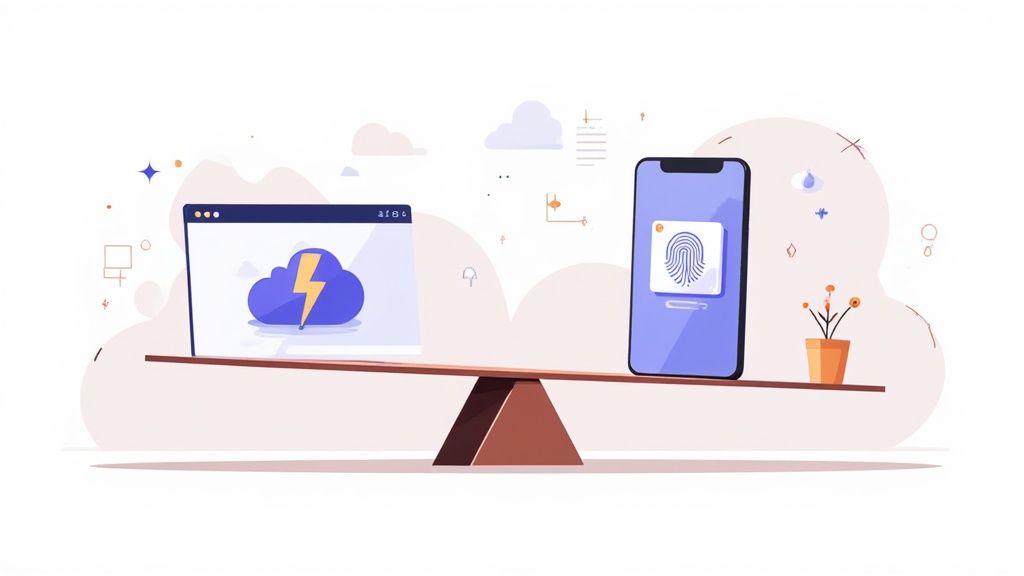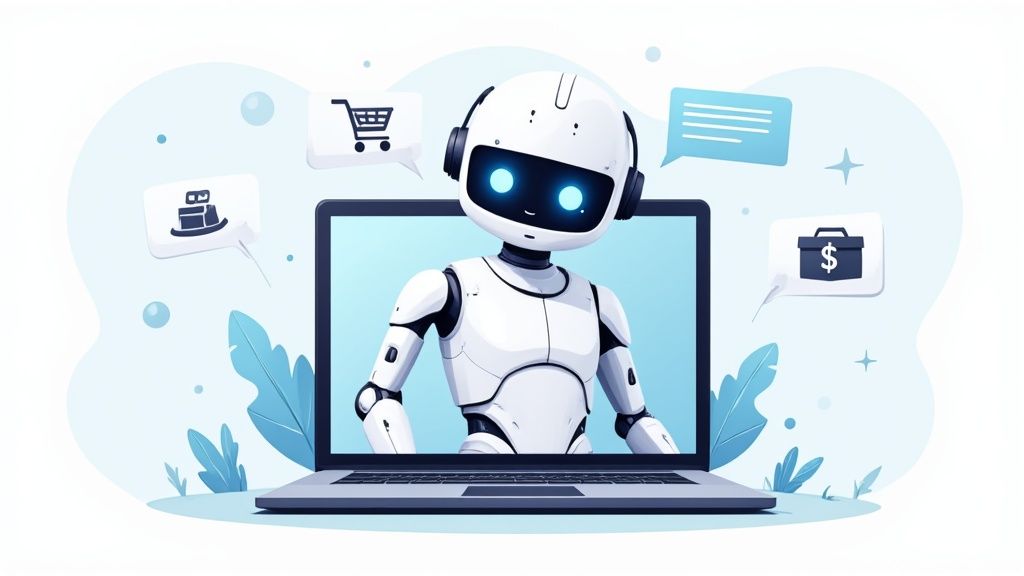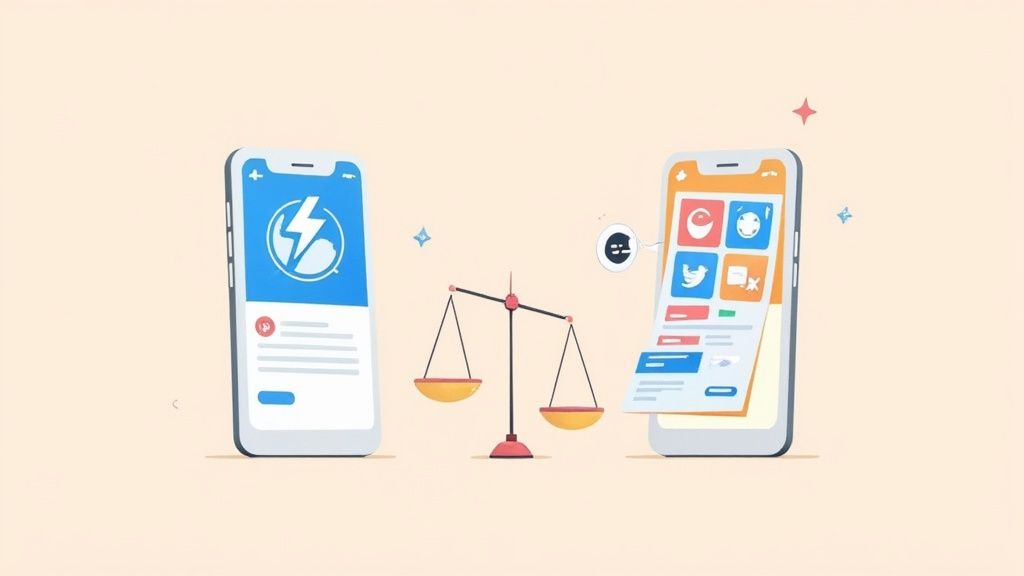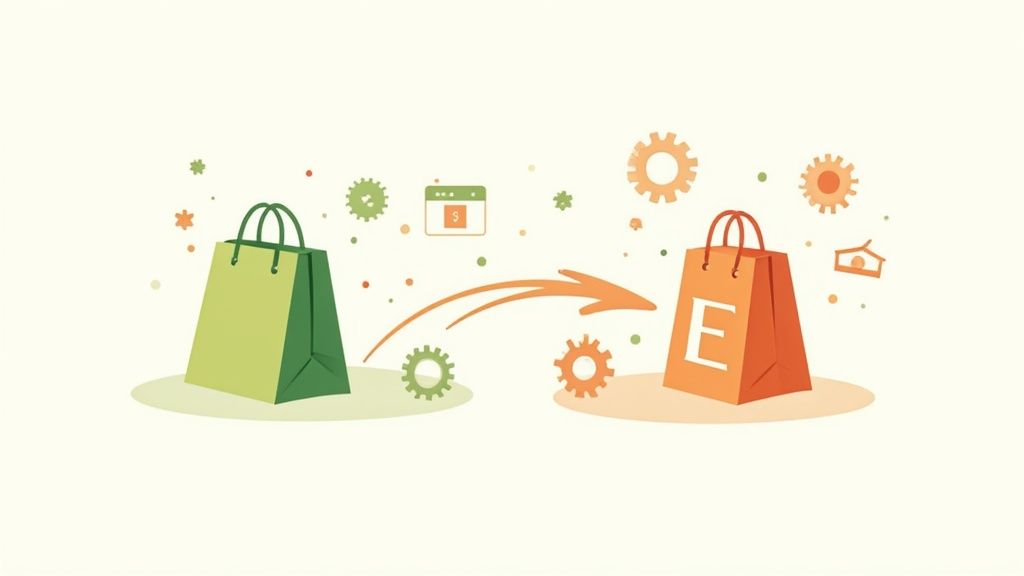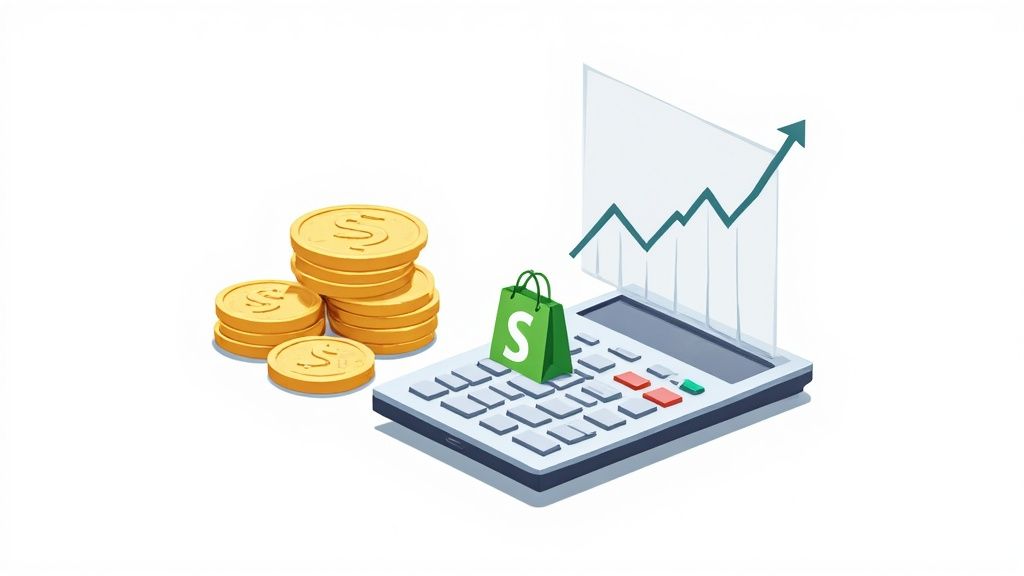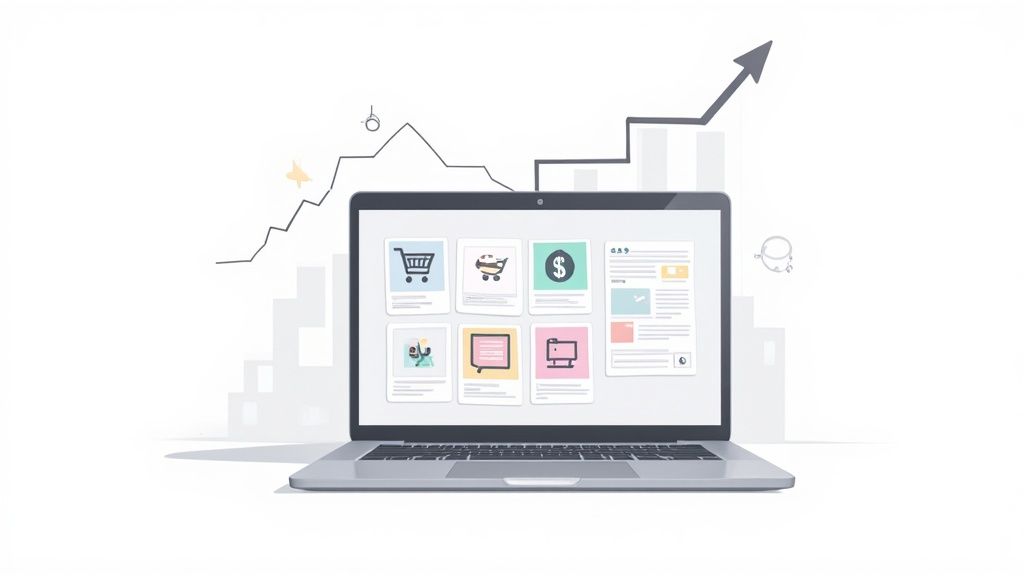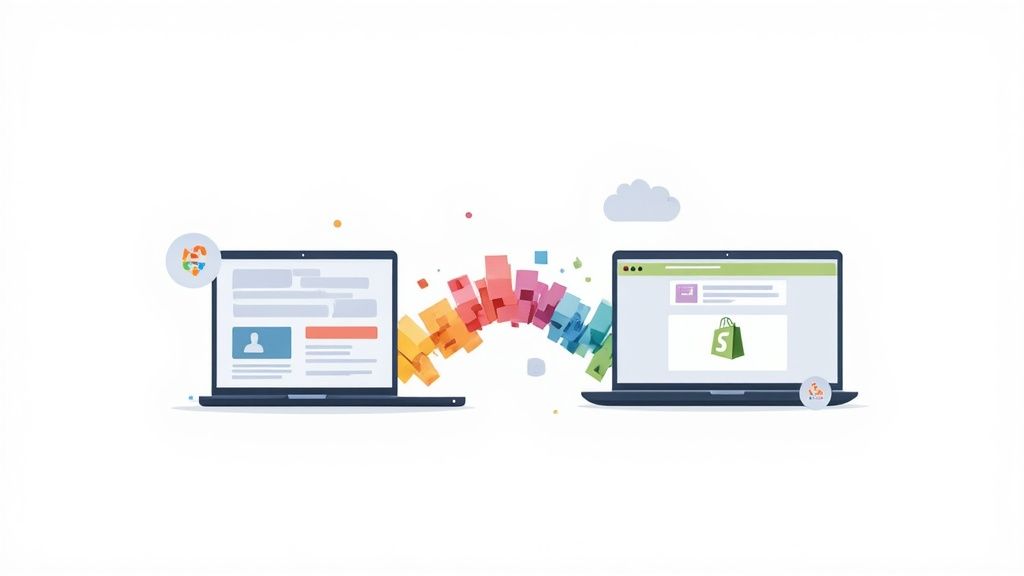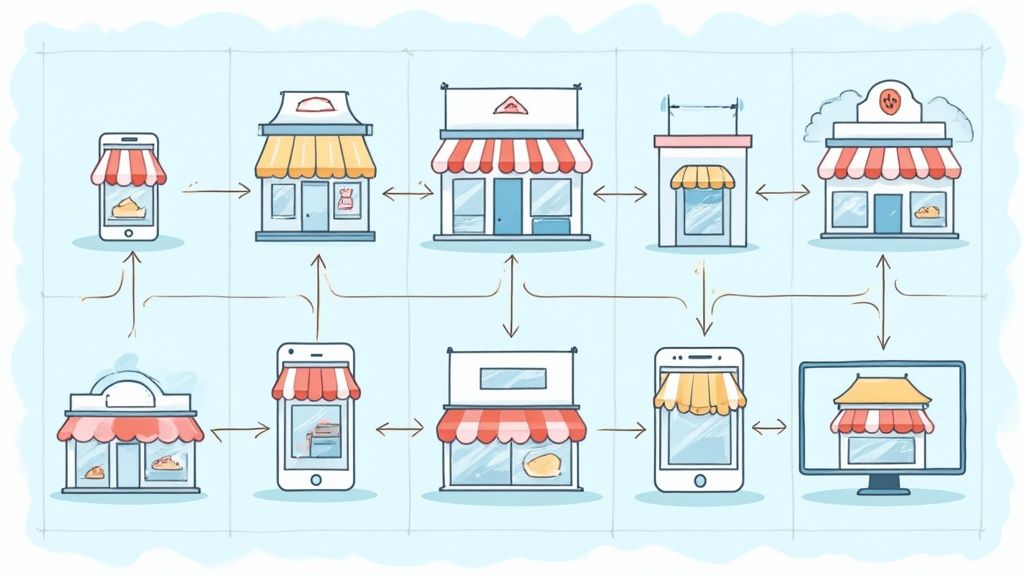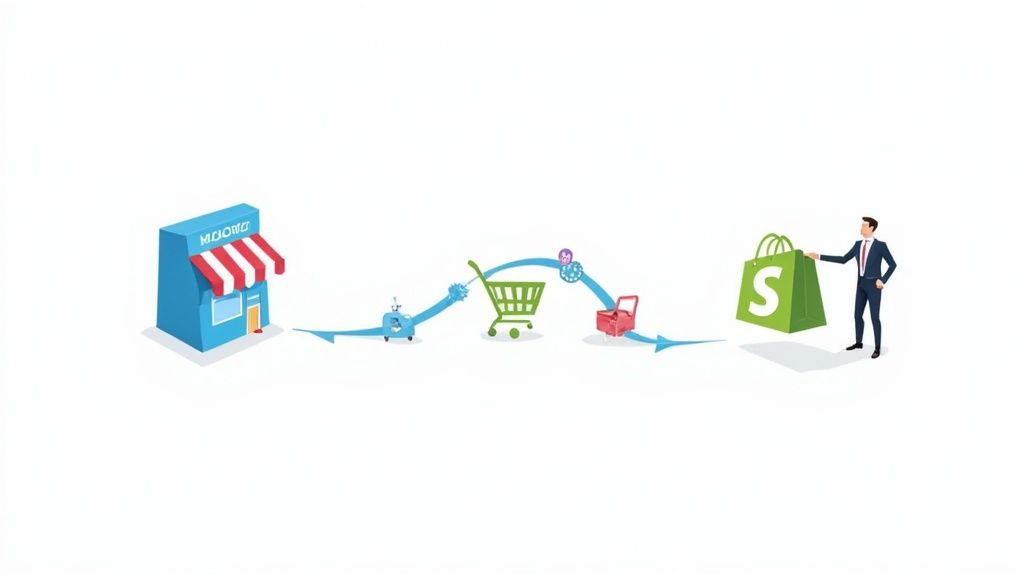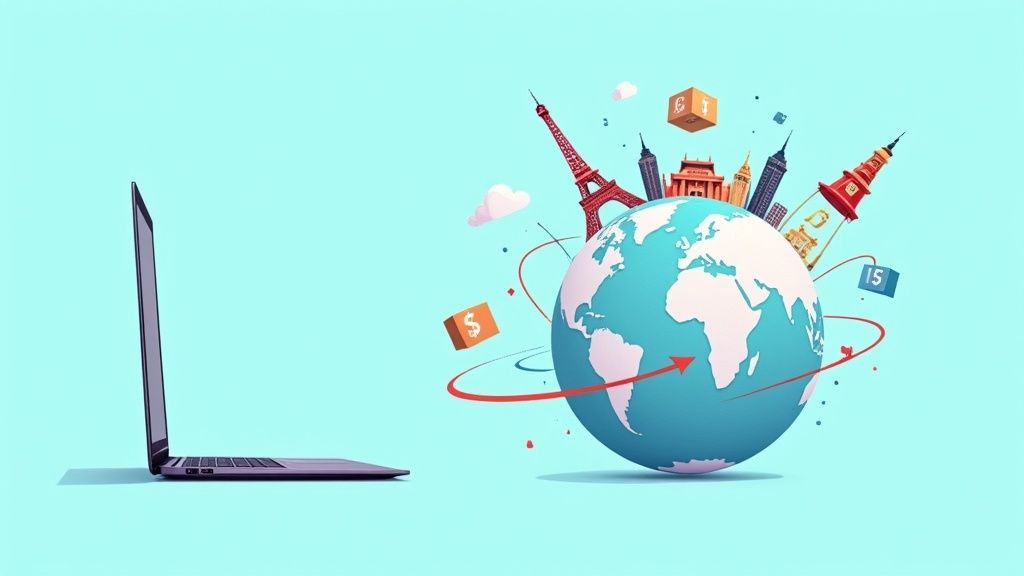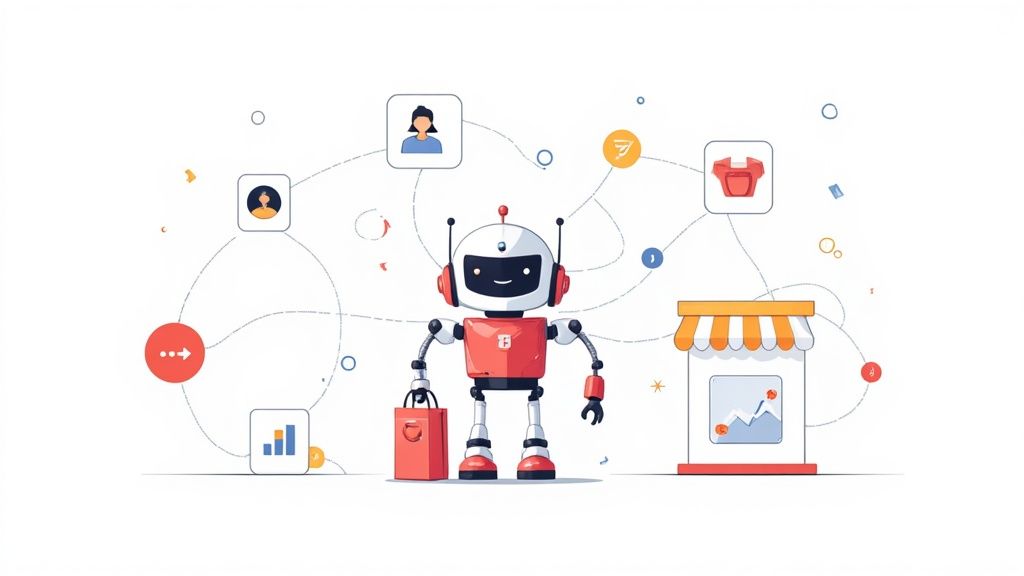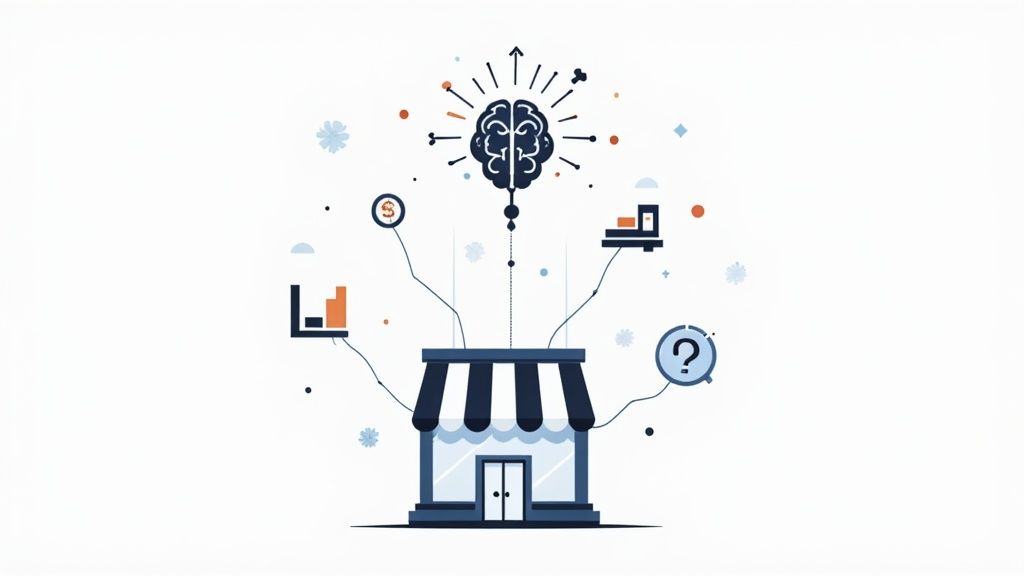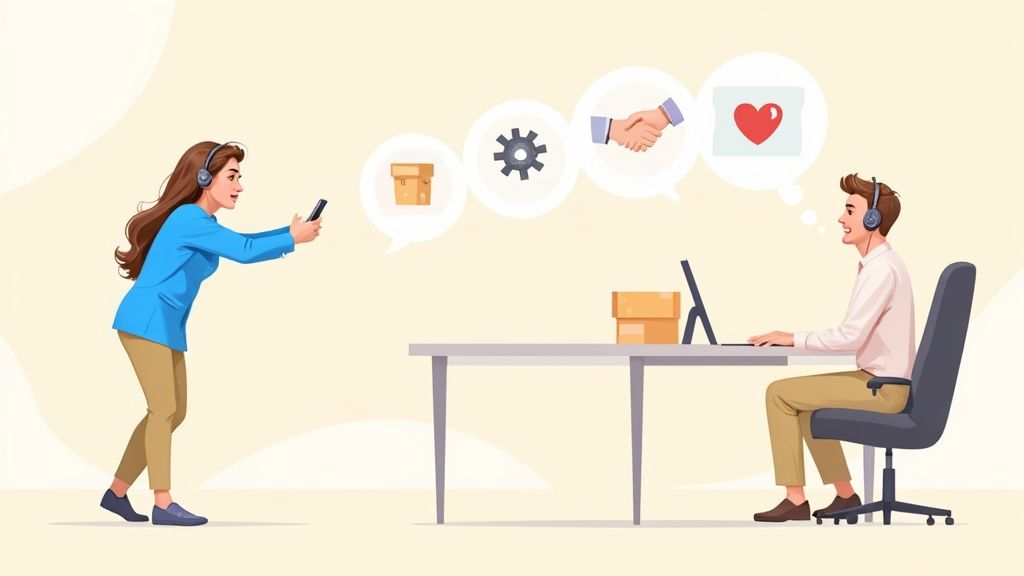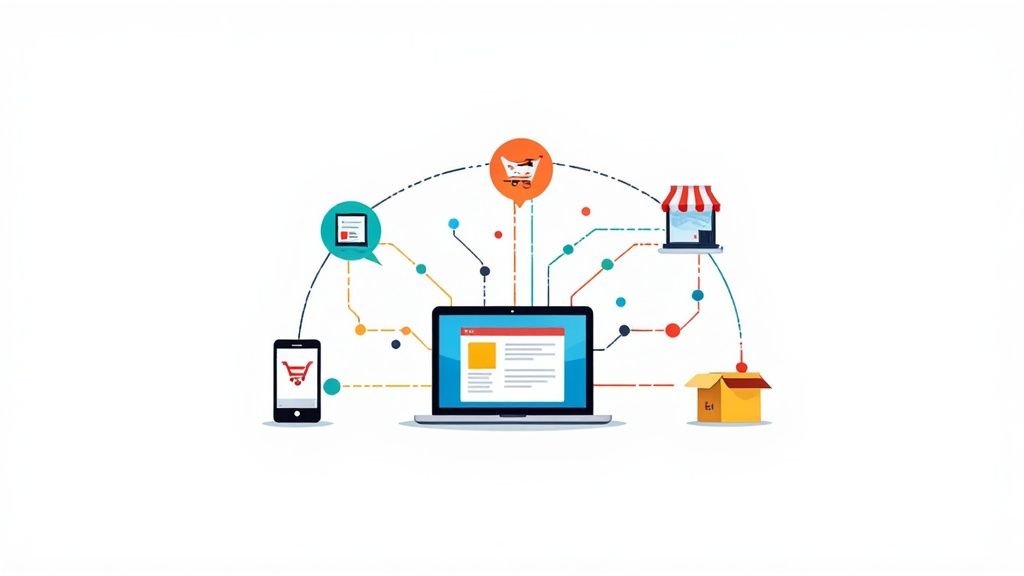
A multichannel sales strategy is all about selling your products on more than one platform. Think of it as meeting your customers wherever they happen to be shopping. This could mean you're active on your own website, have a shoppable Instagram feed, and also list your products on a massive marketplace like Amazon—all at the same time.
The goal is pretty straightforward: expand your reach and make it incredibly easy for people to buy from you.
Why A Multichannel Sales Strategy Is No Longer Optional
Let's be real, your customers are everywhere, and your business needs to be too. The days of a simple, linear path to purchase are long gone. A typical shopper today might see your product in a social media ad, pop over to Google to read reviews, check prices on a marketplace, and then finally land on your Shopify store to use a special discount code. This isn't some fringe behavior; it's the new normal.
This fundamental shift in how people shop is exactly why a multichannel sales strategy has moved from a "nice-to-have" to a "must-have" for any brand that wants to grow. If you’re only selling from a single channel—whether it’s just your physical store or only your website—you’re essentially invisible to a massive chunk of your potential market.
Meet Customers Where They Are
Showing up on the platforms your customers already know and love is a powerful way to build brand familiarity and trust. More importantly, it removes friction. When it's easy to buy, people are more likely to complete their purchase. This demand for convenience is a huge economic driver.
The multichannel marketing market is expected to skyrocket from $6.96 billion in 2023 to an estimated $28.6 billion by 2030. A big reason for this explosive growth? A staggering 97% of consumers admit to backing out of a purchase simply because it wasn't convenient. You can dig into more of these multi-channel marketing statistics to see just how much convenience shapes buying habits.
The core idea is simple: Don't make customers come to you. Go to them. By offering multiple touchpoints for engagement and purchase, you cater to diverse shopping habits and preferences, significantly increasing your chances of making a sale.
The proof is in the numbers. The data below shows just how much a multichannel approach can boost key metrics like revenue and customer retention compared to sticking with just one channel.
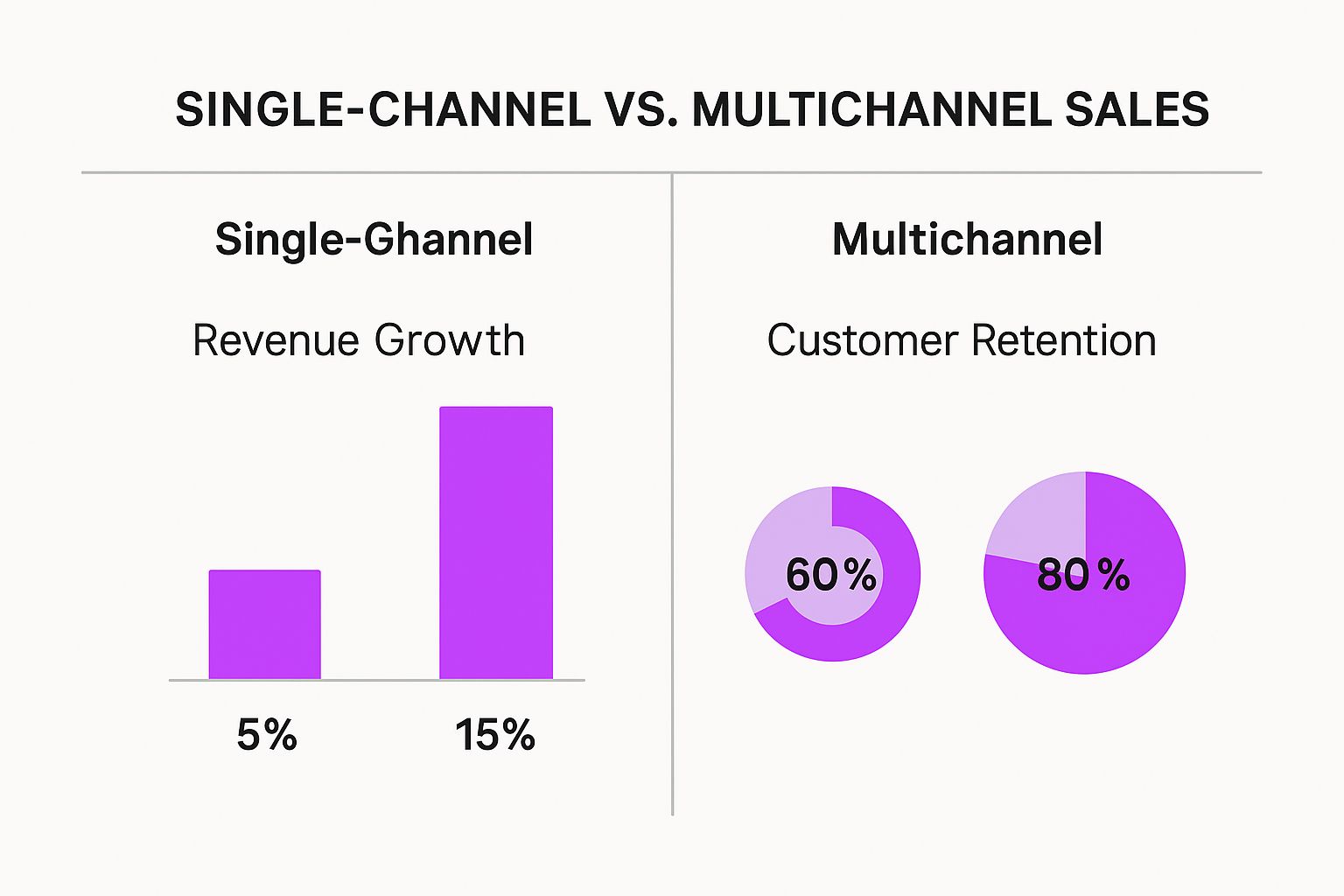
As you can see, businesses that embrace multiple sales channels don't just see a small bump—they experience substantially higher revenue growth and hold onto more of their customers over the long haul.
Multichannel vs. Omnichannel Clarified
Before we get into the nitty-gritty, it’s important to clear up a common point of confusion. The terms "multichannel" and "omnichannel" are often used as if they mean the same thing, but they describe two very different levels of strategy and integration.
Think of multichannel as your starting point. You're present in multiple places, but each channel operates mostly on its own. Omnichannel is the more advanced, integrated evolution.
Here's a table to break down the key differences:
Key Differences: Multichannel vs. Omnichannel
In simple terms, multichannel is about having several different doors to your store. Omnichannel ensures that no matter which door a customer uses, they get the exact same consistent, connected, and helpful experience inside.
For this guide, we’re focused on building that strong multichannel foundation. It's the essential first step before you can ever achieve a truly seamless omnichannel future.
Choosing the Right Sales Channels for Your Brand
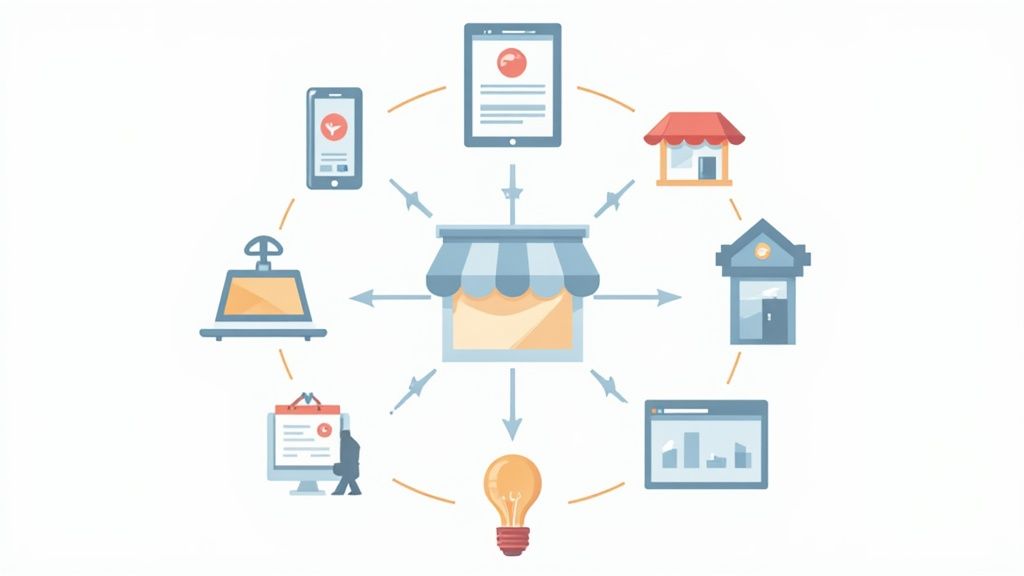
It’s tempting to think that getting your brand onto every platform imaginable is the key to growth. But that’s a classic misstep—one that drains your resources and dilutes your brand message faster than anything else. A truly powerful multichannel sales strategy isn't about being everywhere. It's about showing up in the right places, intentionally and with real impact.
To do this, you need to get brutally honest about your business from three different angles: where your ideal customers actually spend their time, which channels are a natural fit for your products, and what your team can realistically manage without dropping the ball.
There's no one-size-fits-all answer here. A craft coffee roaster might kill it with a killer Shopify store and highly visual sales on Instagram Shopping. Meanwhile, a B2B software company could be crushing its goals by focusing almost exclusively on LinkedIn outreach. Both strategies work because they're focused.
Pinpoint Your Customer's Digital Hangouts
First things first: stop guessing where your customers are and start using data to find them. The goal is to build a detailed picture of your target audience's online life. This goes way beyond basic demographics like age and location. You need to understand their psychographics—their habits, their interests, and where they turn online.
Where do they go for product recommendations? Are they scrolling TikTok and influenced by creators, or do they dig into detailed reviews on niche forums? A brand selling skateboards is going to find its people in entirely different corners of the internet than one selling high-end kitchenware.
To get real answers, try these tactics:
- Survey Your Existing Customers: Just ask them. A simple survey asking where they first heard about you and which social platforms they use daily can be incredibly revealing.
- Analyze Your Website Traffic: Fire up Google Analytics and see where your visitors are coming from. Is your traffic driven by organic search, social media, or referrals from other sites?
- Scope Out the Competition: Take a hard look at where your successful competitors are most active. Their presence offers a huge clue about where your shared audience hangs out.
Once you have a shortlist of channels, you need to learn how to play the game on each one. For instance, if your audience is all about visuals and social media, learning how to effectively sell products on Instagram could open up a massive new revenue stream.
Match the Channel to Your Product
Not every product makes sense on every channel. This seems obvious, but it’s a critical filter. High-consideration or complex products often need a lot of educational content. They do best on platforms where you can host detailed product pages, long-form videos, and in-depth customer reviews, like your own website or a dedicated YouTube channel.
On the flip side, impulse buys and visually striking products are built for social commerce. That unique, handmade necklace is a perfect candidate for an impulse buy from an Instagram Story. A complex piece of home gym equipment? Not so much. That requires a full-blown product page with tech specs, FAQs, and financing options.
Pro Tip: Don't try to shove a square peg into a round hole. If your product isn't a good fit for a channel, don't force it. Trying to sell complex B2B services with a TikTok dance challenge is just burning resources. Your product's story has to align with the platform's strengths.
Here’s a quick way to think about it:
Assess Your Operational Capacity
Now for the reality check. Every new sales channel you add brings more operational complexity. It’s another stream of orders to fulfill, another inventory count to sync, another inbox of customer questions to manage, and another feed of marketing content to create.
Be honest with yourself about what your team can actually handle. It's far, far better to deliver an amazing customer experience on two channels than a sloppy, mediocre one on five.
Before you jump on the latest marketplace or social selling feature, ask if you truly have the bandwidth for the extra work. There's a reason companies that nail their channel mix see an average 9.5% increase in annual revenue—it's because they execute flawlessly, not because they're everywhere. The goal is to build a focused, high-impact strategy that you can actually sustain for the long haul.
Integrating Your Channels for Seamless Operations

So you’ve decided where you want to sell. That’s a great first step, but it’s just the beginning. The real magic—and frankly, what separates the pros from the amateurs—is what happens behind the scenes. This is where your grand strategy gets its hands dirty with operational reality.
Without a connected, unified system, your multichannel sales strategy can quickly unravel into pure chaos. I'm talking about inventory nightmares, frustrating fulfillment delays, and customer data that's scattered to the winds.
The goal here is to build a seamless operational backbone where every channel talks to the others in real time. This is how you avoid those classic multichannel blunders, like selling an out-of-stock item on Amazon because a sale on your website hadn't synced yet. You want to ensure that no matter where a customer finds you, their experience is smooth and their data is captured accurately.
Shopify as Your Central Command Center
For most e-commerce brands I’ve worked with, the smartest way to wrangle this complexity is by using a platform like Shopify as a central command center. Think of it as the brain of your entire sales operation. It becomes the single source of truth connecting your website, social media storefronts, marketplace listings, and even your physical point-of-sale (POS) systems.
When you set it up this way, every single sale, return, and customer interaction gets funneled back to one central dashboard. This unified view is what makes everything else possible.
And the results speak for themselves. Multichannel retailing is a powerful force, with some retailers reporting average quarterly sales growth of more than 150% year over year. Better yet, businesses that fully integrate these channels into a unified commerce solution see an average annual sales uplift of 8.9%. You can learn more about how unified commerce drives sales on Shopify's blog.
A disconnected system creates data silos. When your pop-up shop operates independently from your online store, you end up with two separate customer lists and two different inventory pools. Integration breaks down these walls, giving you a complete picture of your business.
Essential Tools for a Connected System
While Shopify provides the core foundation, a few specialized tools can seriously level up your efficiency. The two most critical pieces of the puzzle are Inventory Management Systems (IMS) and Customer Relationship Management (CRM) software.
Inventory Management Systems (IMS): As you add more sales channels, keeping tabs on stock levels becomes exponentially harder. An IMS is built specifically to solve this headache by giving you real-time, centralized inventory tracking across all your sales outlets. If you're serious about scaling, check out our guide on multi-channel inventory management to get started.
Customer Relationship Management (CRM): A good CRM pulls customer data from every touchpoint into a single, detailed profile. It tracks purchase history, support tickets, and email interactions, no matter where they happened. This is what empowers you to deliver truly personalized marketing and support that actually feels personal.
A Real-World Integration Scenario
Let's walk through a practical example. Imagine you run a growing apparel brand. You have a solid Shopify store and you've just started doing weekend pop-up shops to get the word out.
Here’s how a connected system creates a brilliant experience:
- A new customer discovers your brand at the pop-up and buys a t-shirt using your Shopify POS system. You capture their email during the sale.
- Instantly, because your POS is synced, their purchase history and contact info are added to your central CRM.
- The inventory for that t-shirt is immediately updated across your Shopify store and any other connected marketplaces, killing any chance of overselling it online.
- The next day, that same customer automatically gets a "Thank You" email with a small discount for their next online purchase.
Without integration, this entire sequence falls apart. The pop-up sale would be a one-off transaction, and that customer would remain a ghost to your online marketing. By connecting your channels, you turn a one-time, in-person buyer into a long-term, loyal customer who feels seen and valued—no matter how they choose to shop.
This operational harmony is the true engine of a profitable multichannel sales strategy.
Crafting a Cohesive Multichannel Marketing Plan
So, you're selling on multiple channels. That means you need to market on them, too. But a winning multichannel marketing plan is much more than just spamming the same ad everywhere. The real goal is to create a unified front that feels authentically you on every platform, while also being perfectly tuned to that channel's audience.
Think of your brand as a central theme, and each marketing channel is a different instrument in an orchestra. The sound might change from a violin to a trumpet, but they're all playing the same beautiful melody. This is how you build a brand, not just a business.
Unifying Your Brand Voice Across Platforms
Consistency is the bedrock of customer trust. When your visuals, tone of voice, and core message are the same across your website, social media accounts, and marketplace listings, people start to recognize you. More importantly, they start to trust you. It builds credibility and makes your brand feel professional and reliable.
A shopper should be able to jump from a funny TikTok you posted to your professional Amazon storefront and then to your email newsletter without feeling a jarring disconnect. The content will naturally be different, but the brand personality shining through must stay the same.
Make sure these core elements are locked in everywhere:
- Visual Identity: Your logos, color schemes, and fonts should be instantly recognizable.
- Brand Voice: Whether you're witty, inspirational, or super professional, keep that tone consistent.
- Core Messaging: Your unique selling proposition—what makes you special—needs to be crystal clear on every channel.
The Art of Content Repurposing
Trying to create brand-new, original content for every single channel is a one-way ticket to burnout. Trust me. The smarter, more sustainable approach is to create one big "pillar" piece of content and then slice and dice it for different platforms. This saves a massive amount of time while still tailoring the message for maximum impact.
Let’s imagine you just wrote an amazing, 2,000-word product guide on your blog about your new smart coffee maker. That one article can fuel your marketing for weeks.
Here’s how you could spin that single blog post into a full marketing campaign:
- TikTok & Reels: Film a quick, 30-second video showing off the coffee maker's single coolest feature. Slap on some trending audio and text overlays. Done.
- LinkedIn: Create an informative carousel post that highlights the top three ways the machine boosts productivity for busy professionals.
- Instagram Live: Host a live Q&A. Actually brew a coffee on camera, answer questions from the audience in real-time, and share a few user tips you included in the guide.
- Email Newsletter: Send a punchy summary of the guide to your email list with a direct link to buy the coffee maker, maybe even with a special discount code just for subscribers.
This is how your multichannel sales strategy gets powered by a marketing engine that's dynamic and context-aware, not just a repetitive echo.
Your goal is not to say the same thing everywhere, but to tell the same story in different ways. Each piece of repurposed content should feel native to the platform it's on, providing value in the format that users expect.
Creating a Powerful Flywheel Effect
The real magic happens when your channels stop acting like lonely islands and start working together. You want to create a self-reinforcing flywheel where each channel not only promotes your products but also promotes your other channels. This creates a web of engagement that keeps customers bouncing around inside your brand's ecosystem.
If you really want to master this and create a seamless journey for your customers, you should look into building an omnichannel marketing strategy.
This synergy is what turns one-off interactions into a continuous customer relationship.
Actionable Flywheel Tactics:
- Cross-Channel Promotions: Send an email blast hyping a 24-hour flash sale happening exclusively on your Amazon store. This drives traffic and boosts your sales velocity right where you need it.
- Retargeting Loops: Use Facebook and Instagram ads to show a specific product to people who just viewed that same product on your Shopify store but didn't pull the trigger.
- Community Building: Use your email list and social posts to invite your best customers to a private Facebook group or Discord server. This creates a powerful hub for your most loyal brand advocates.
When you start implementing tactics like these, you stop treating your channels like separate projects and start running them as an interconnected network. This integrated approach makes every marketing dollar and every minute of your time work harder to amplify your message and drive sales across your entire business.
Measuring Performance and Optimizing Your Strategy
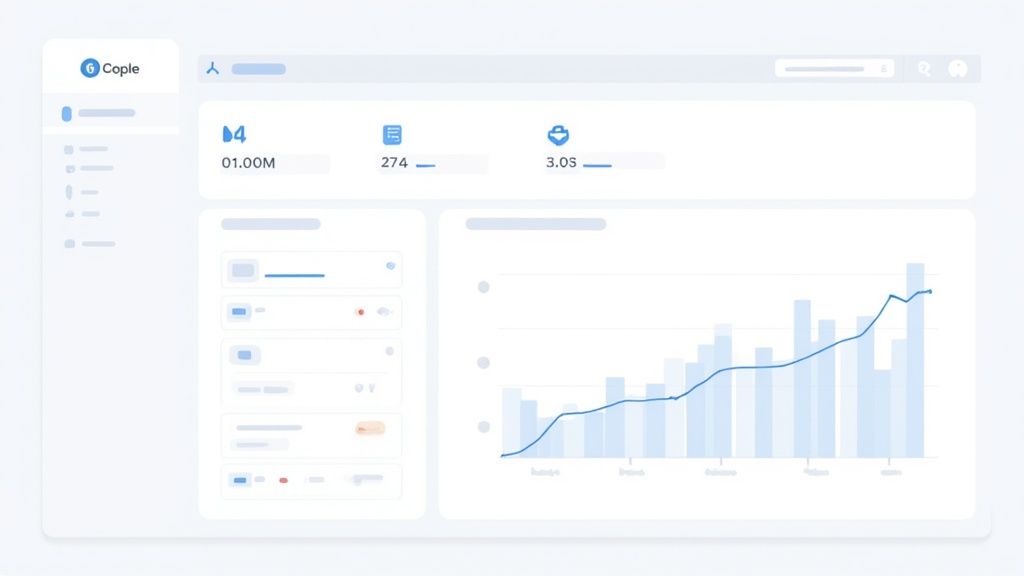
Launching a multichannel sales strategy without measuring it is like trying to navigate a ship without a compass. Sure, you're moving, but you have no clue if you're heading toward treasure or trouble. You can't improve what you don't measure, and in e-commerce, making smart, data-backed decisions is what separates the brands that scale from the ones that stagnate.
The trick is to look past vanity metrics like follower counts or total website visits. Instead, you need to zero in on the hard numbers that tell the real story of each channel's performance and profitability. This is how you discover what’s actually working and where your marketing dollars will have the greatest impact.
Identifying Your Core Performance Metrics
To get a truly clear picture of your success, you need to track a specific set of Key Performance Indicators (KPIs). These metrics help you evaluate each channel not just on its sales volume, but on its efficiency and the long-term value it brings to your business.
Your analytics dashboard should be your mission control, set up to track these crucial numbers:
- Customer Acquisition Cost (CAC) per Channel: This is your total marketing and sales spend on a channel, divided by the number of new customers you won through it. Knowing it costs $50 to acquire a customer via Google Ads versus $15 from an Instagram campaign is powerful information for budget planning.
- Channel-Specific Conversion Rates: What percentage of people on each channel actually buy something? A high-traffic channel with a rock-bottom conversion rate often points to a problem with your product listings, pricing, or the overall user experience on that platform.
- Average Order Value (AOV) per Channel: Are customers from certain channels spending more per purchase? You might find that shoppers arriving from your blog spend more than those coming from a marketplace, which should absolutely influence where you invest your content efforts.
- Customer Lifetime Value (CLV) by Channel: This is the ultimate metric. It reveals the total revenue you can expect from a customer acquired on a specific channel over their entire relationship with your brand.
For a bird's-eye view of your overall marketing health, I also recommend tracking your marketing efficiency ratio. This helps you understand the true return on every dollar you spend.
A Real-World Optimization Scenario
Let's walk through a real-world example. I once worked with a retailer selling premium leather goods across their Shopify store, Amazon, and Etsy. For months, they were thrilled with their Amazon sales, which made up 60% of their total orders.
But when we dug into the data, the numbers told a different story. Their Customer Acquisition Cost on Amazon was triple that of their Shopify store, thanks to high ad spend and fees. Even more telling, the Customer Lifetime Value of an Amazon shopper was 40% lower. Why? Because those customers rarely came back to buy directly from the brand; their loyalty was to Amazon, not the leather goods company.
This data-driven insight was a complete game-changer. They realized their most profitable customers—not just their highest-volume ones—were coming from their own website. This led to a major strategic shift, moving a huge chunk of their Amazon ad budget into SEO and content marketing for their Shopify store.
This kind of analysis is the bedrock of a sustainable business. By identifying which channels bring in the most valuable customers, you can fine-tune your approach for maximum profitability. This is a core pillar of any successful ecommerce growth strategy.
The data backs this up time and again. Campaigns that span three or more channels see order rates nearly five times higher than single-channel efforts. Even better, companies with strong multichannel engagement retain an average of 89% of their customers, and those customers prove to be worth 30% more in lifetime value. That’s the power of a well-measured and optimized multichannel strategy in action.
Common Questions About Multichannel Sales
As you start branching out, you're going to hit some snags and have plenty of questions. That’s not just normal; it’s a sign you’re doing it right. Let’s walk through some of the most common hurdles I see business owners face and give you some straightforward, practical answers.
How Many Sales Channels Are Too Many?
Honestly, there’s no magic number here. The right number of channels comes down to your team’s capacity and, most importantly, where your customers actually spend their time. The goal is always quality of execution over quantity of channels.
My advice? Start small. Nail your primary channel—usually your own website—and then thoughtfully add one or two more where you know your audience is hanging out. If you can't deliver stellar customer service, keep inventory straight, and create content that feels native to a new channel, you’re spread too thin.
It's far more powerful to be a top performer on a couple of key channels than to be a mediocre presence on ten. Stretching yourself too far can backfire, damaging your brand's reputation and wiping out any potential gains.
What Are the Biggest Mistakes to Avoid?
Venturing into multichannel sales is exciting, but there are a few common pitfalls that can trip up even the most seasoned entrepreneurs. Knowing what they are ahead of time is half the battle.
Here are the top five mistakes you’ll want to steer clear of:
- Inconsistent Branding: If your logo, messaging, or visuals change from platform to platform, you’re creating confusion and weakening your brand. Customers should instantly recognize you, no matter where they find you.
- Siloed Systems: The single biggest technical blunder is not connecting your inventory and order data. This is how you end up selling out-of-stock items, which leads to fulfillment nightmares and very unhappy customers.
- One-Size-Fits-All Content: Just copying and pasting the same post everywhere is lazy and ineffective. It ignores why people are on that platform in the first place. A polished, professional LinkedIn post should look nothing like a fun, trendy TikTok video.
- Neglecting Customer Service: Every new channel is another inbox to monitor. If you aren't checking for questions and issues everywhere you sell, you’re guaranteeing a poor customer experience and leaving money on the table.
- Ignoring the Data: If you don't track how each channel performs, you're flying blind. You have no real way of knowing which channels are actually making you money and which are just a drain on your resources.
Can a Small Business Really Manage Multiple Channels?
Absolutely. The idea that multichannel is only for massive corporations is a complete myth. For a small business, the key is to be incredibly strategic, start small, and prioritize efficiency from the get-go.
Don't feel the pressure to be everywhere at once. Start with your e-commerce store as your home base. Then, add just one other high-impact channel that feels like a natural fit—think Etsy for handmade goods or Instagram Shopping for a visual brand.
The secret for small teams is to lean heavily on technology. A platform like Shopify can act as your command center, automatically syncing inventory and orders from different sales channels. This slashes manual work and prevents the kind of costly errors that can sink a small operation.
Focus on creating an amazing, seamless experience on a couple of channels before you even think about expanding. This focused approach is how small businesses can compete and win.
How Do I Manage Inventory Across Different Channels?
This is probably the most critical operational puzzle you'll solve, and the solution is one word: centralization. Trying to manually update stock levels on your website, a marketplace, and a social media shop is a recipe for disaster.
Using a modern e-commerce platform like Shopify or a dedicated Inventory Management System (IMS) is non-negotiable. These tools become the single source of truth for your stock. When a product sells on Amazon, your inventory is instantly updated on your Shopify store and every other channel you’re connected to.
It’s this real-time synchronization that prevents you from overselling and having to cancel orders. For businesses with brick-and-mortar stores or more complex needs, investing in a robust IMS is one of the smartest decisions you can make. It gives you tight operational control and keeps the customer experience smooth.
Ready to build a powerful and profitable multichannel presence? At ECORN, we specialize in helping brands design, develop, and optimize their Shopify stores to act as the central hub for their entire sales ecosystem. Book a call with our Shopify experts today and let's scale your business together.







